Main
News
About health
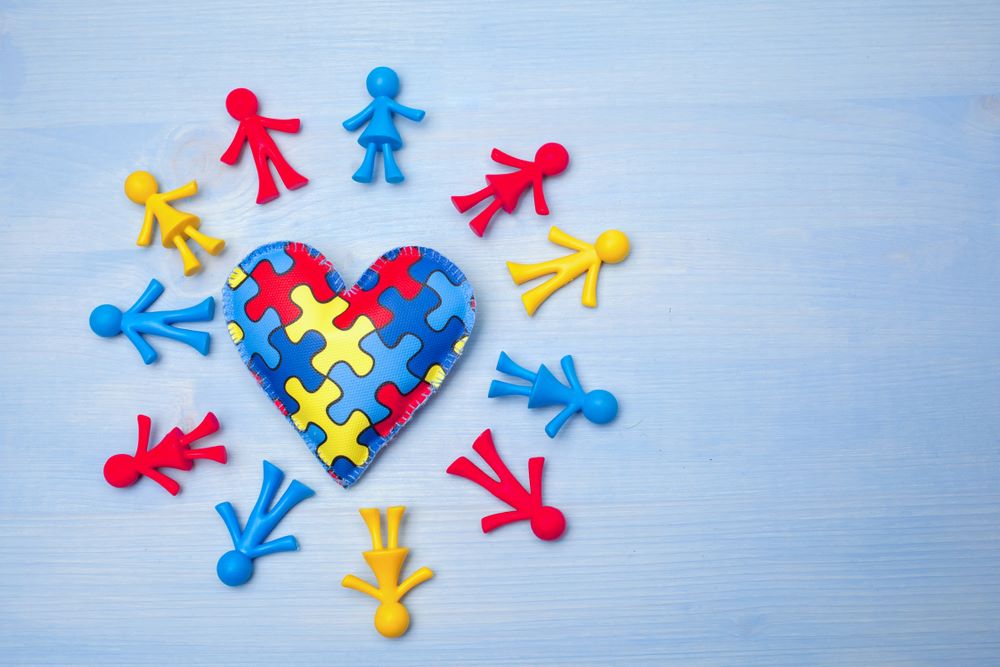
April 2nd: World Autism Awareness Day
02 April 24
April 2nd has been marked in the medical calendar since 2007, designated by the UN General Assembly. The goal is to raise awareness and knowledge about individuals with autism, their rights, and opportunities.
This year, for the first time, individuals with autism themselves will share their experiences at an international forum, representing various regions. The theme of the day is “Moving from Surviving to Thriving: Autistic Individuals share regional perspectives.”
“Arabkir” Medical Center is one of the first organizations addressing autism-related issues in our country, if not the very first. In the early 90s, our specialists from the "ArBeS" Health Center underwent training in the USA and European countries. They participated in courses and international conferences featuring the latest programs in pediatric rehabilitation, developmental pediatrics and related fields. They then brought this professional knowledge back to Armenia, laying the groundwork for the establishment of new services, including autism diagnosis, supervision, and the formation of specialized teams to work with children.
It is essential to recognize that autism, like any other condition, can affect anyone. No one is immune, and being well-informed and taking appropriate steps in such cases is crucial.
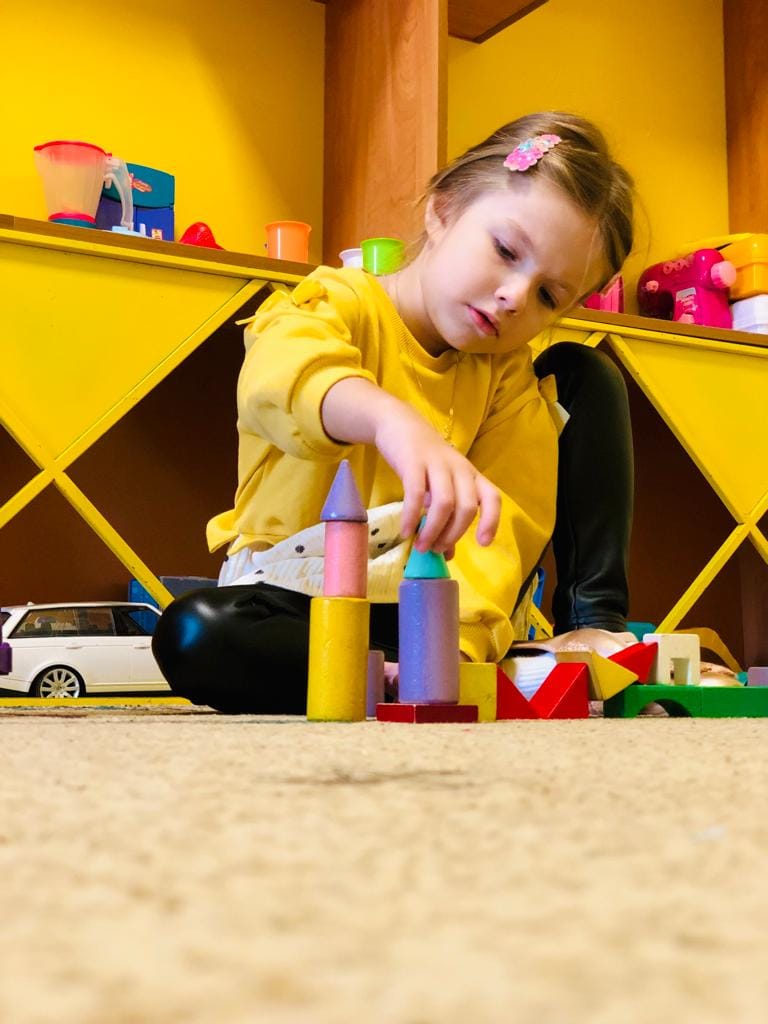
Kindergarten “DINO”
28 March 24
Kindergarten “DINO” was established with the co-founding of the “Arabkir” Medical Center. “DINO” is licensed by the Ministry of Education and Culture of the Republic of Armenia for the purpose of implementing a preschool educational program. It has three groups:
nursery: 1,5-3 years old,
middle: 3-5 years old,
senior: 5-6 years old.
Each group is limited to 15 children.
“DINO” is open Monday through Friday from 8:30 AM to 6:00 PM, with a nap time from 1:30 PM to 3:30 PM.
In addition to the tasty meals, we offer a daily "vitamin hour" with fresh fruits and veggies.
In "DINO", apart from the complex educational programs, there are also alternative programs that are continuously changed and updated in accordance with the requirements of the time. Here your child will learn important skills like:
fluent speech
foreign languages
basic mathematics
ethics
Your child can also join programs like:
singing
dance
karate
summer school
training classes.
Address: Yerevan, Vahe Vahyan 2
E-mail: [email protected]
Phone number: +374 98 342 702 and +374 95 557 163
https://www.facebook.com/profile.php?id=100078210485841
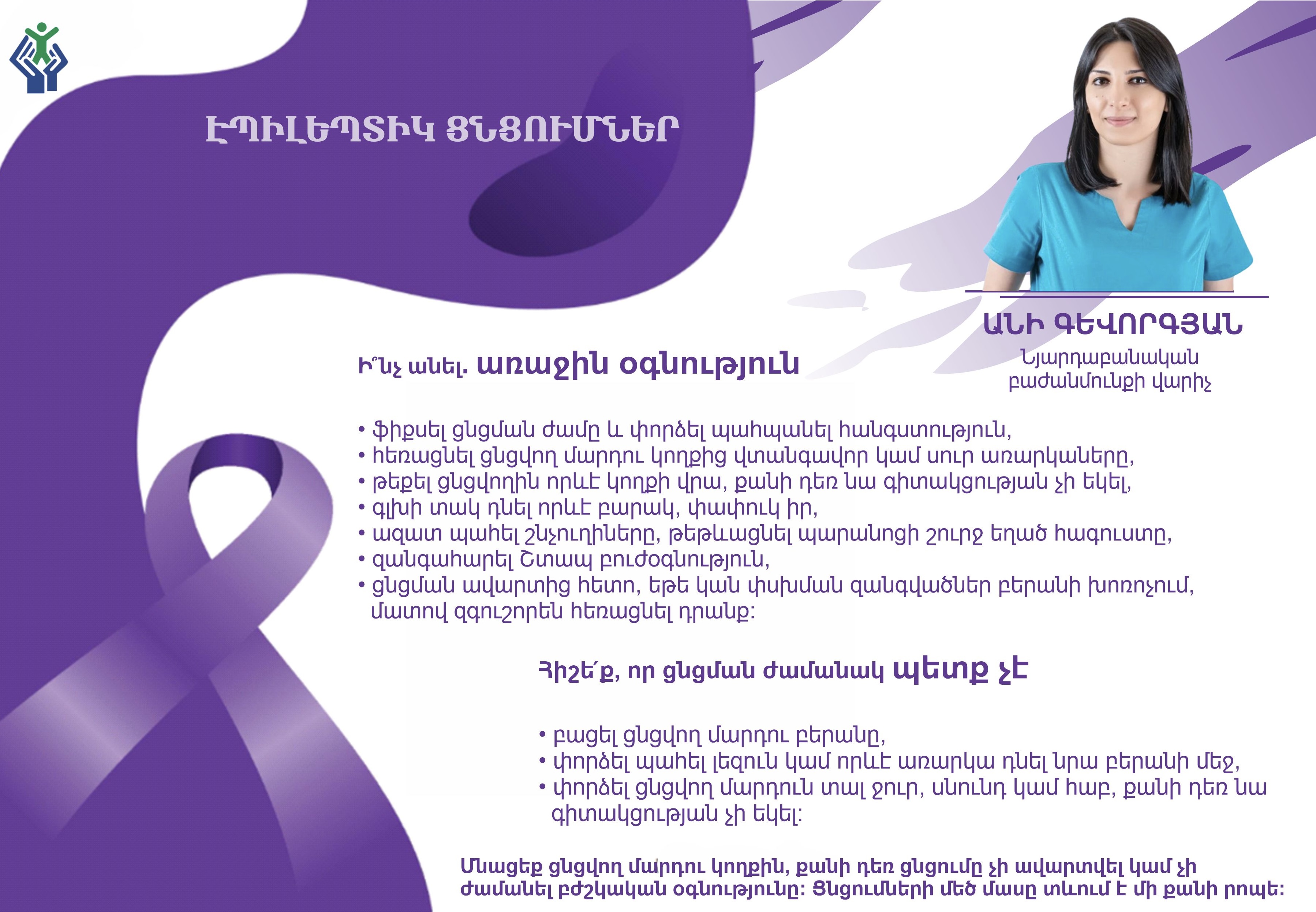
Purple Day
26 March 24
Today, March 26, is Purple day, also known as Epilepsy Awareness Day.
This day was initiated by nine-year-old Cassidy Megan, who wrote a letter sharing her experience of living with epilepsy. She encouraged people to see epilepsy not as a sentence, but as a condition to live with, just like any other.
Epilepsy affects 65 million people worldwide, with the causes remaining unknown in 50% of cases. It can affect anyone, regardless of age, gender, nationality, or social status.
In Armenia, many children with epilepsy receive care at the Department of Neurology and Epileptology of the "Arabkir" Medical Center. Our dedicated team of specialists strives to provide the best possible care, staying up-to-date with modern medical advancements in diagnosis, treatment, and surgery.
Here are some simple tips from Ani Gevorgyan, the head of the Neurology Department at the "Arabkir" Medical Center, on what to do and not to do if you witness someone having an epileptic seizure.
Stay calm and start timing the seizure.
Remove any sharp and dangerous objects near the person.
Turn them on their side.
Place something soft under their head.
Loosen any tight clothing around their neck and keep the airway clear.
Call an ambulance.
If they have food or fluid in their mouth, remove it after the seizure is over.
Do not try to open their mouth.
Do not put anything in the person’s mouth.
Do not give them food, water or pills.
Stay with the person until the seizure stops or medical help has arrived. Most seizures last for minutes.
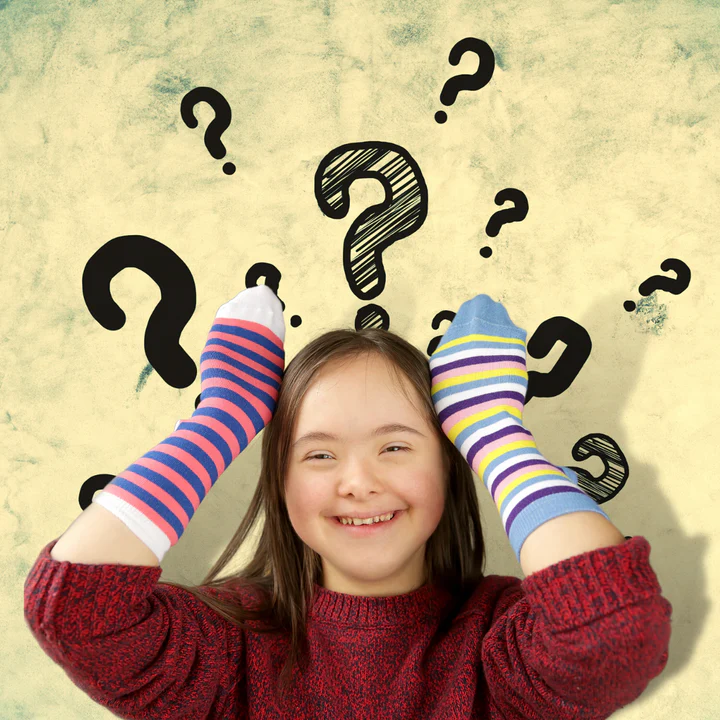
March 21: World Down Syndrome Day
21 March 24
World Down Syndrome Day is marked each year on March 21.
In the medical calendar, this day has been chosen in 2011 by the decision of the UN General Assembly. The goal is to raise public awareness of Down syndrome and advocate for the rights of people with Down syndrome. This year’s slogan for the day is "End the stereotypes". In many countries around the world, the most popular flash mob activity for Down syndrome day involves wearing colorful socks to break stereotypes.
The date 21.03 was not chosen by chance. It is significant because Down syndrome is characterized by the triplication of the 21st human chromosome. Typically, there are two copies of chromosomes, but in this case, there are three, resulting in a total number of 47 chromosomes. And it is this additional 47th chromosome that makes people with Down syndrome unique and recognizable.
According to the World Health Organization, one out of every 1,000 or 1,100 babies is born with Down syndrome. Since this syndrome does not discriminate based on nationality, gender, skin color, or place of residence, it is assumed that the WHO’s estimate applies to all countries, including Armenia, where clear statistics on people with Down syndrome are lacking.
In our country, there are non-governmental organizations dedicated to addressing the issues faced by children and adults with Down syndrome. These organizations aim to promote their inclusion, capacity development, and protection of rights. Doctors, including the specialists at the "Arabkir" medical center, are well-informed about the medical aspects of Down syndrome, such as its tendency to cause cardiac, respiratory, hearing and digestive problems.They focus on providing support and rehabilitation to individuals with Down syndrome, helping to develop their physical skills.
#WorldDownSyndromeDay #ArabkirMC
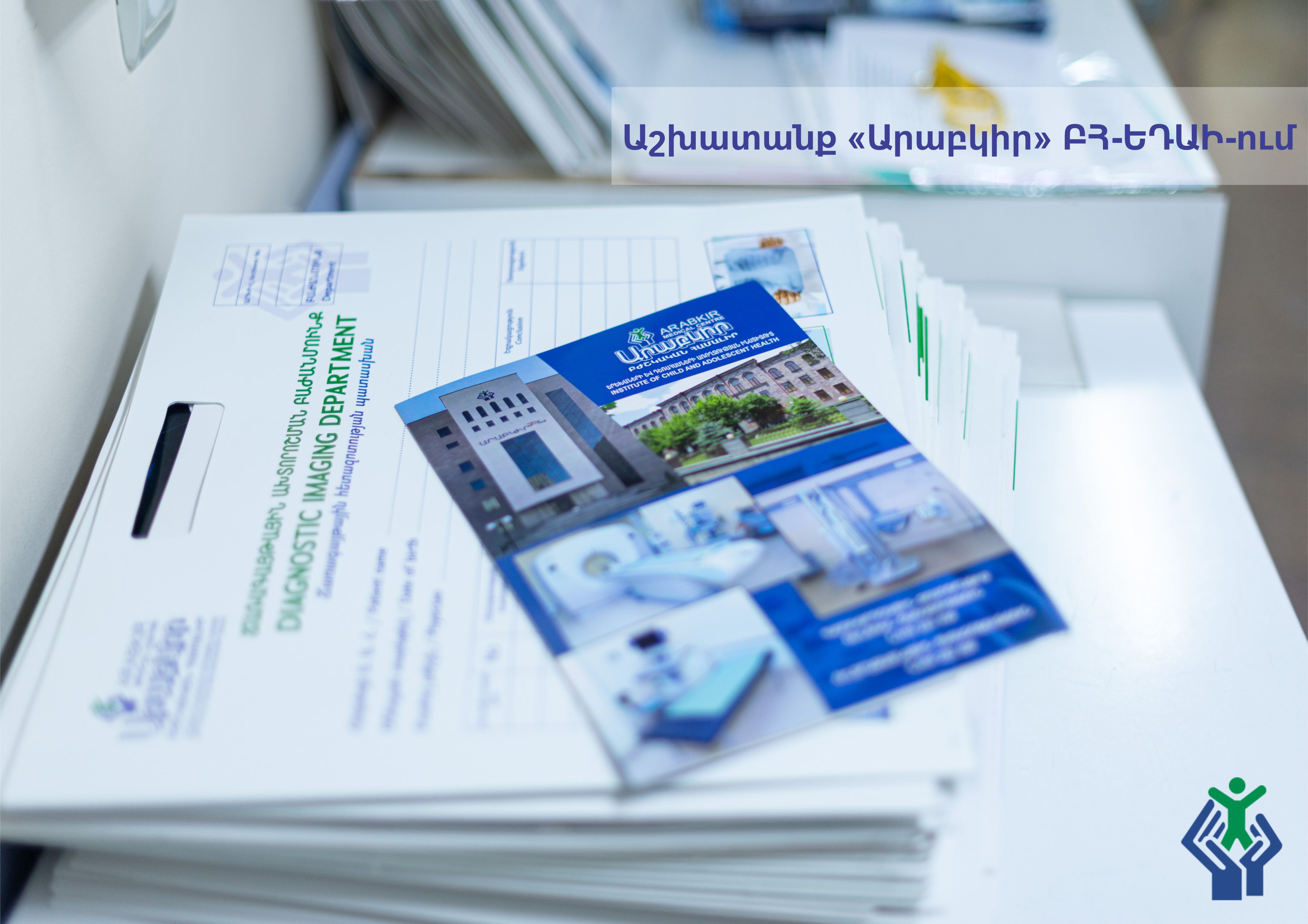
We are hiring an X-Ray technician
20 March 24
The Diagnostic Radiology Service at the “Arabkir” medical center is currently hiring an X-Ray technician.
For more information, please call 015 400 300, extension 11 75.
To apply, please send your CV to [email protected] .
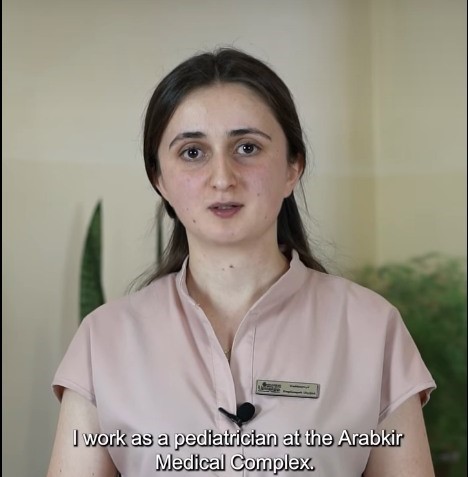
Advice to parents on Respirator Sincitial Virus
19 March 24
Continuing our commitment to #OPENFamilyEducation, we’re sharing valuable advice from our doctors.
Listen to Serine Matevosyan, one of our physicians from the Department of Children under 1 year, as she provides guidance on dealing with respiratory syncytial virus (RSV). Learn what actions can be taken at home, what should be avoided, how to support your child in overcoming virus-related issues, and when it is crucial to seek urgent medical attention.
https://www.facebook.com/reel/1055688485464345

Symposium: Kidney Health for All
18 March 24
Public television also covered the symposium held on the occasion of World Kidney Day. Discover why kidney health is so important, including insights into the most prevalent kidney problems and those that are less common. Learn about the modern methods used for detecting and treating kidney issues. Find out more details in the accompanying video.
From hemodialysis and kidney transplant to onco-nephrology, the “Kidney Health for All” symposium has drawn the participation of over 80 doctors. The event not only features presentations and analyses, but also highlights rare cases encountered in clinical practice.
Ashot Sargsyan, President of the Armenian Pediatric Association and Head of the Nephrology Service at the “Arabkir” Medical Center, remarked: “Among the selected topics, we have prioritized discussions on highly significant diseases affecting various departments and clinics. These include nephrology in oncology, hemolytic-uremic syndrome, and other prevalent conditions.”
Here’s an excerpt from the remarks of Ara Babloyan, the Scientific Director of the “Arabkir” Medical Center: “Nephrology is a complex, fascinating and deeply intricate field of both profession and science. Each aspect requires thorough consideration and dedication, a continual process of giving and receiving knowledge. Today, we embarked on this journey together during our symposium.”
In Armenia, as in the rest of the world, the incidence of kidney pathologies is on the rise each year. Currently, there are over a thousand individuals undergoing hemodialysis treatment, while kidney transplants are exclusively performed using donations from related donors.
Milena Voskanyan, Head of the Follow-up department for Organ Transplant Patients at “Arabkir” Medical Center, remarked: “Today, we will also review the outcomes and advancements of kidney transplantation in Armenia over the years. In the past two decades, we have successfully conducted 245 kidney transplants from related donors, marking significant progress. Notably, we have witnessed the remarkable success of four young women who have undergone kidney transplants and collectively have five children. It's heartening to see both the children and the transplant recipients living healthy lives.”
The symposium also covers primary and secondary pathologies of kidney diseases.
Nerses Ghahramanyan, Head of the Follow-up/Dispensary Department at the Hematology and Chemotherapy Clinic of the Hematology Center after Yolyan under the Ministry of Health of the Republic of Armenia, explained: “I will discuss the diagnosis and treatment of AL Amyloidosis, a rare and serious disease. While several cases are diagnosed each year, treatment typically involves chemotherapy drugs and immunotherapy. In some cases, bone marrow transplantation may be necessary.”
The meeting also addresses hemolytic-uremic syndrome, with presentations on the Armenian experience.
Ashot Sargsyan, President of the Armenian Pediatric Association and Head of the Nephrology Service at “Arabkir” Medical Center, shared: “Hemolytic-uremic syndrome has become prevalent in Armenia, with recent outbreaks observed. This condition, commonly found in children, has also affected adults. We even encountered a case of a pregnant woman who successfully delivered after undergoing long-term dialysis, which is a significant achievement.”
Many kidney diseases develop without noticeable symptoms and can only be detected through regular screenings.
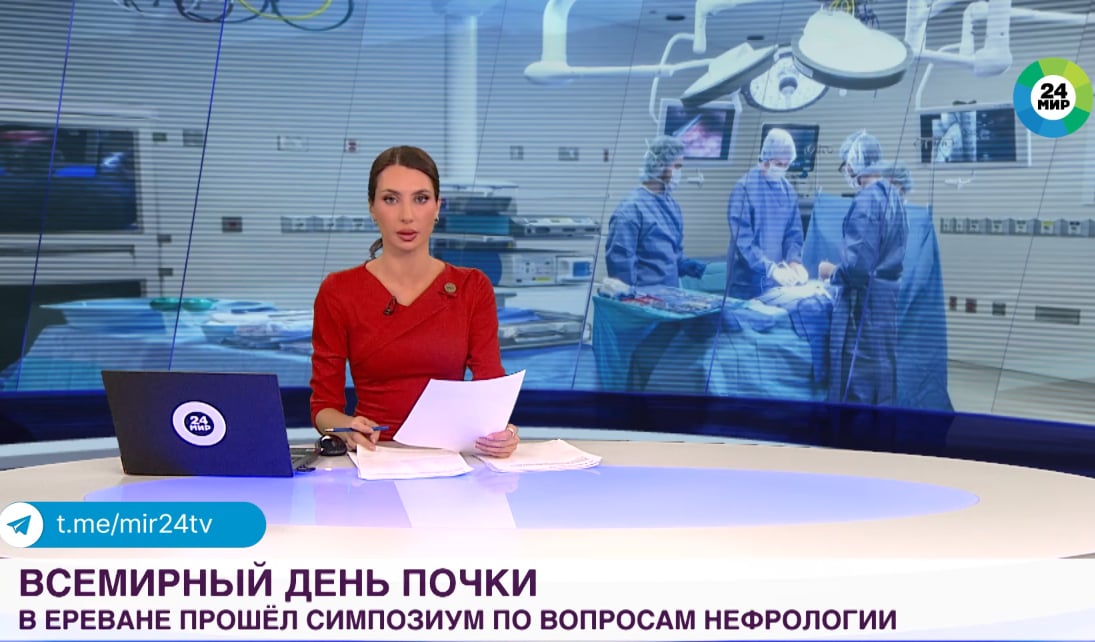
Mir TV on World Kidney Day Symposia
16 March 24
Watch the video from “Mir” TV company covering the symposium dedicated to World Kidney Day.
The slogan for the day is “Kidney health for everyone: prioritizing access to care and treatment.”
#WorldKidneyDay2024
#ArabkirMC
https://mir24.tv/.../vsemirnyi-den-pochki-v-erevane…

News.am on World Kidney Day Symposia
15 March 24
News.am reports on the symposium held to mark World Kidney Day, an event chosen in the medical calendar primarily to raise public awareness and discuss diseases and their prevention. The speeches at the symposium were predominantly professional yet informative.
https://med.news.am/.../erikamayin-anbavararutyunn-aylevs...
#WorldKidneyDay #ArabkirMC
Kidney failure is no longer considered a death sentence. What treatment methods are available in Armenia today, and what advancements can we expect in the future?
Just 50 years ago, kidney failure, along with most other kidney diseases, was often perceived as a terminal condition. However, today, patients with these diseases in Armenia are focusing not on life expectancy, but on improving their quality of life and selecting the most suitable treatment for their specific circumstances.
The development of nephrology and onco-nephrology in Armenia, introduction of advanced treatment methods of kidney diseases, including transplantation. All these topics were discussed during a symposium organized at the “Arabkir” Medical Center - Institute of Children and Adolescent Health in honor of World Kidney Day, a global event celebrated since 2006.
Professor Ashot Sargsyan, the Head of the Nephrology, Hemodialysis and Kidney Transplantation Clinic at the “Arabkir” Medical Center, highlighted to NEWS.am Medicine that the purpose of World Kidney Day is to raise awareness about kidney diseases, which are increasingly prevalent worldwide. The symposium focused on addressing the most pressing issues currently faced in Armenia concerning kidney health.
Nephrology in Armenia: Progressing from a “life sentence” to Hemodialysis Implementation
Pediatric urologist-surgeon, Doctor of Medical Sciences and Professor Ara Babloyan shared with NEWS.am Medicine that in the 1960s and 1970s, it was commonly believed that individuals with kidney failure faced an unpromising future. Unfortunately, during those years, this belief was not unfounded, as there were limited options available for such patients in Armenia.
The severity of the situation became evident following the 1988 Spitak earthquake, where many survivors tragically died due to the lack of hemodialysis equipment.
As explained by Dr. Helen Nazaryan, Head of the Hemodialysis and Kidney Transplant Department, some survivors who were trapped under rubble for extended periods developed a condition known as “Crash syndrome”, characterized by acute kidney failure. For these individuals, continuous hemodialysis treatment, sometimes lasting up to 40 days, was crucial for recovery and future quality of life. Without dialysis, survival was unlikely.
Regrettably, this was the fate for many earthquake victims. Despite international aid efforts, there remained a shortage of dialysis machines.
Following the earthquake, hemodialysis machines were introduced in Armenia, as explained by Dr. Nazaryan. Specialized departments were established in various hospitals, and medical personnel received training. Today, there are 16 hemodialysis departments across the country, all equipped with state-of-the-art facilities.
Transplantation: New Hope and Improved Quality of Life
While hemodialysis can rescue individuals from potential death in cases of kidney failure, undergoing this procedure three times a week for 15-20 years can pose certain challenges and adversely affect their quality of life. Dr. Nazaryan also noted that for pediatric patients, persistent dialysis can slow down their growth and development. For such individuals, a kidney transplant offers a solution, promising a fuller life.
According to Professor Babloyan, the first kidney transplant surgeries in Armenia date back to the 1970s.Initially sporadic, these operations became more frequent after 1991. By 1994, approximately 20 kidney transplants from deceased donors had been conducted in Armenia, with organs often procured from Leningrad (now Saint Petersburg), as Dr. Nazaryan recalled.
Following the dissolution of the Soviet Union, the country encountered certain challenges, resulting in a hiatus in transplant surgeries for several years. However, in 1999, Professor Babloyan successfully performed two more transplants. Subsequently, with the enactment of the Organ Transplantation Law in 2002, such procedures became more regular.
As highlighted by Helen Nazaryan, from 2002 to the present, Armenia has witnessed 245 kidney transplants from living donors, offering renewed hope and improved quality of life for recipients.
Next steps: Cadaver Donors and Artificials Organs
Currently, up to 22 kidney transplants are performed annually in the republic. However, there is a much larger number of hemodialysis patients who require transplants, currently estimated at about 1,200.
For many of these patients, suitable donors cannot be found. However, the development of cadaver donation in the country could significantly improve the lives of at least some of these patients.
As mentioned by Dr. Nazaryan, there are currently no legal obstacles to cadaveric organ and tissue donation in Armenia, but there are some challenges related to the mindset of both the population and medical staff. Overcoming these obstacles and initiating organ transplantation from brain-dead individuals could potentially save the lives of many patients with serious kidney disease.
According to Ashot Sargsyan, addressing certain issues related to transplantation from both living and cadaver donors in the near future is desirable. Primarily, this includes addressing the issue of organ rejection, where the recipient's body rejects the transplanted organ. To prevent this, immunosuppressants are currently used, which unfortunately come with numerous unwanted side effects.
If a solution can be found, perhaps through genetic engineering or other methods, to make the recipient's body tolerant to the transplanted organ, eliminating the need for immunosuppression, it would mark a significant advancement in kidney disease treatment. Efforts in this direction are already underway, with many doctors and patients worldwide eagerly awaiting the results.
However, experts remain uncertain about the timeline for the development of artificial or 3D-printed organs for transplantation. According to Dr. Sargsyan, the kidney is a highly complex and “smart” organ, making it challenging to create an artificial replica. While he does not discount the possibility for the future, it remains uncertain. Additionally, xenotransplantation, the transplantation of organs from animals, may become a possibility in the near future, but significant scientific advancement would be required to achieve this.
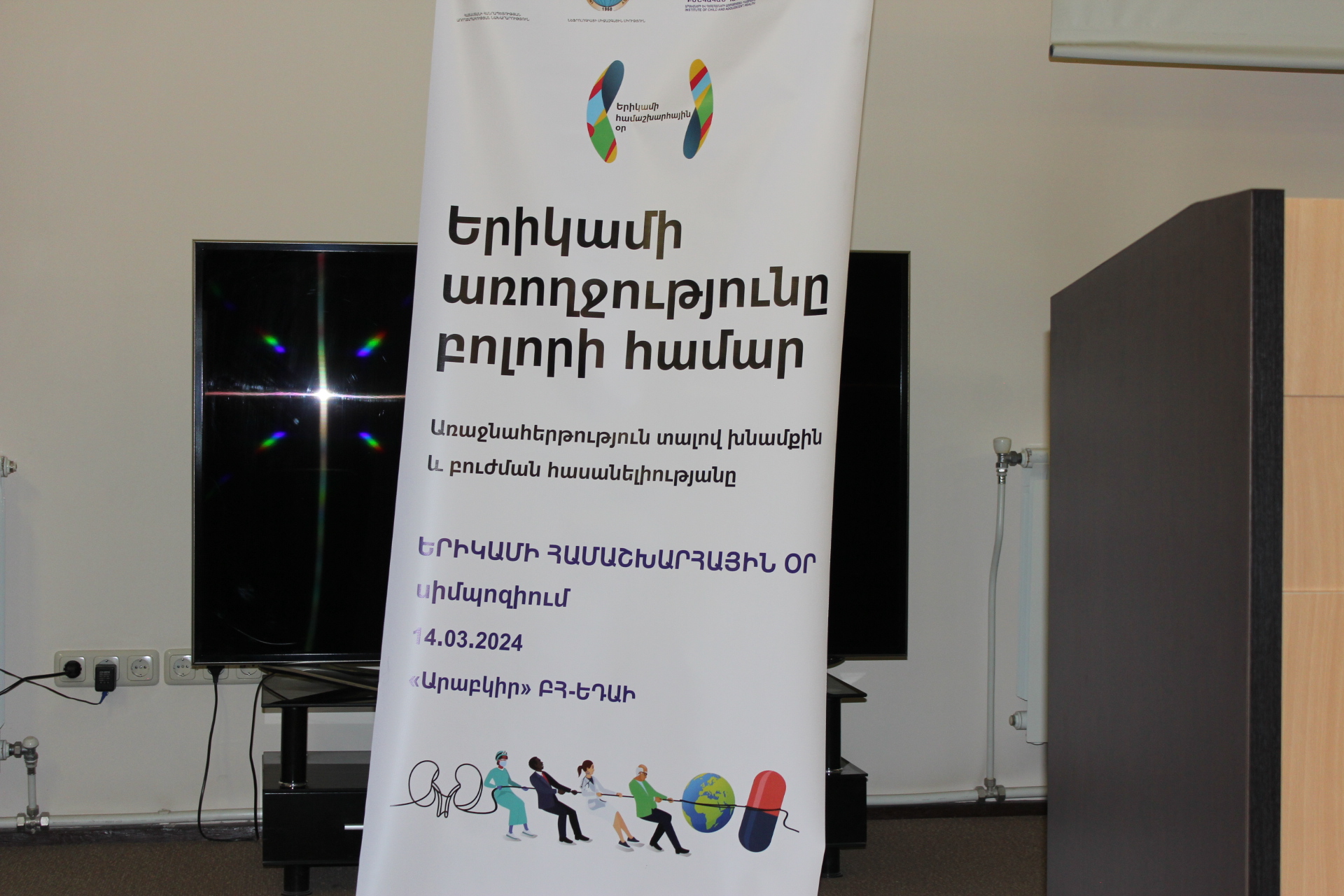
World Kidney Day 2024. Symposium on Kidney Health
14 March 24
On March 14 in the frames of the World Kidney Day 2024, the Symposium on Kidney Health was held with participation of more than 85 medical doctors -pediatric and adult nephrologists, hemodialysis and intensive care doctors, surgeons and other specialists..
Professor Ara Babloyan - Scientific Head of the Arabkir MC and Professor Ashot Sarkissian – Head of Nephrology service of Arabkir MC, President of Armenian Association of Nephrologists, Hemodialysis and Transplant doctors and Armenian Pediatric Association - welcomed the participants.
Scientific program of the Symposium was dedicated to AL Amyloidosis and developments of Onconephrology, Haemolytic Uremic Syndrome (HUS), Achievements and problems of Kidney Transplantation in Armenia.
Lectures have been provided by specilaists of Arabkir MC, Mikaelyan University hospital, Hematology Center after Prof. Yolyan, National Center of Oncology named after Prof. Fanarjyan, Atsghik MC. Outstanding clinical cases were presented and discussed.
The symposium was organized by the Armenian Pediatric Association in collaboration with Arabkir MC, Armenian Association of Nephrologists, Hemodialysis and Transplant doctors under support of the International Society of Nephrology.
The participants will be issued the certificates with CME credits.
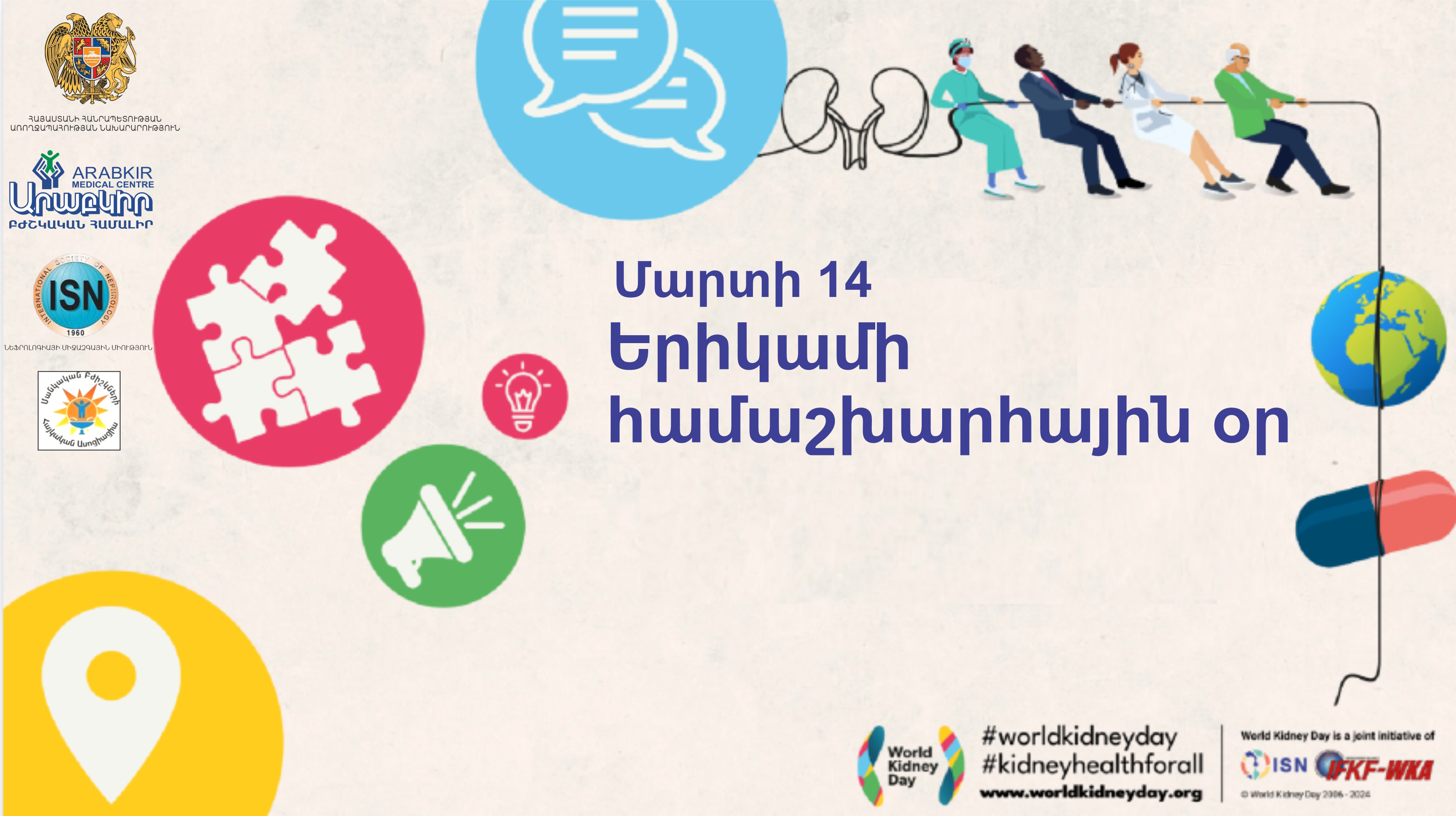
March 14: World Kidney Day 2024
14 March 24
Kidneys are complex and interesting organs, often described in medical literature as a pair of fist-sized organs, located deep within the abdomen, beneath the rib cage. They perform numerous vital functions to maintain our health. Among these functions, the most fundamental is filtering toxins from the blood and regulating water balance. Additionally, kidneys play a crucial role in controlling our blood pressure, producing red blood cells, and ensuring bone health by regulating mineral levels such as sodium and potassium, as well as maintaining the body’s acid-base and water balance.
In honor of World Kidney Day, a symposium will be held today at 15:00 in the conference hall of the “Arabkir” Medical Center. This event is organized jointly by the Armenian Pediatric Association, Armenian Society of Nephrology, Hemodialysis and Transplantation, with the support of the International Society of Nephrologists.

Discounts up to 30%
08 March 24
On the occasion of spring holidays, we’re offering discounted prices on the following tests:
Vitamin D3 - 7000 AMD (instead of 10 000 AMD)
Thyroid stimulating hormone (TSH) - 3 500 AMD (instead of 4 500 AMD)
Anti-Peroxidase antibodies (Anti TPO) - 4 900 AMD (instead of 5 500 AMD)
Antithyroglobulin antibodies (Anti TG) - 4 900 AMD (instead of 5 500 AMD)
Free thyroxine (FT4) - 3 500 AMD (instead of 4 500 AMD)
Triiodothyronine (T3) - 3 600 AMD (instead of 4 500 AMD)
Get tested from March 8 to April 7 with up to 30% off regular prices.
Yerevan, Mamikonyants 30
015 400 300, ext. 11 36
[email protected]
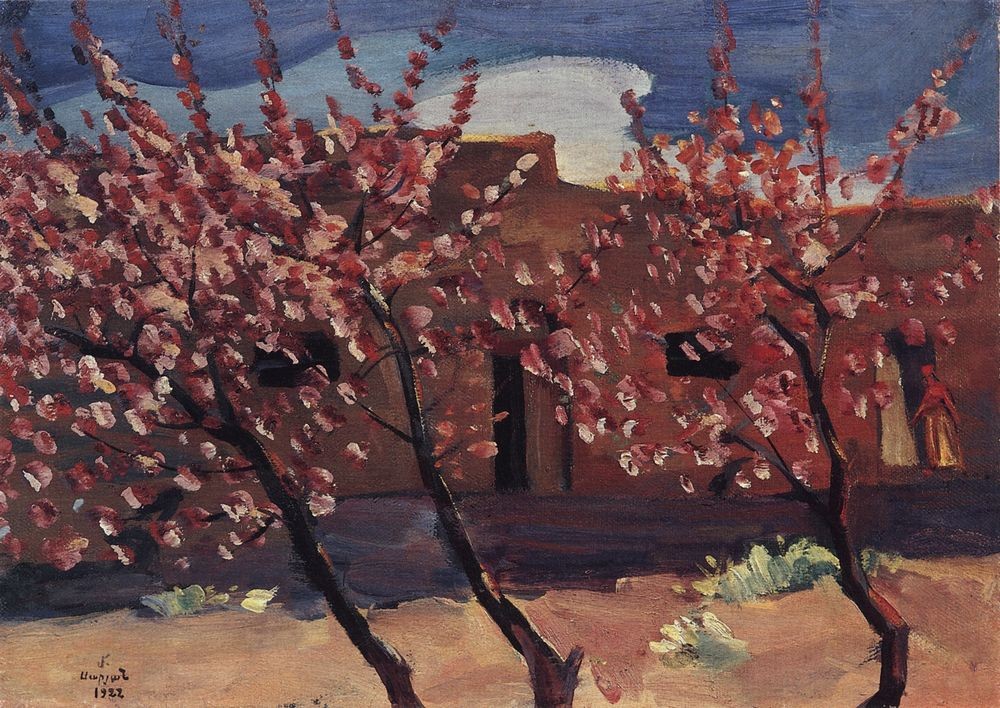
Happy Women’s Day!
08 March 24
Dear mothers, wives, sisters, daughters and colleagues,
The holidays provide us with the perfect opportunity to celebrate the eternal and boundless love that connects us. We wish you health, tranquility, and the joyous spirit of spring. Thank you for gracing our lives with your presence, adding beauty to our world, and above all, for your unwavering dedication to keeping us and our little ones healthy.
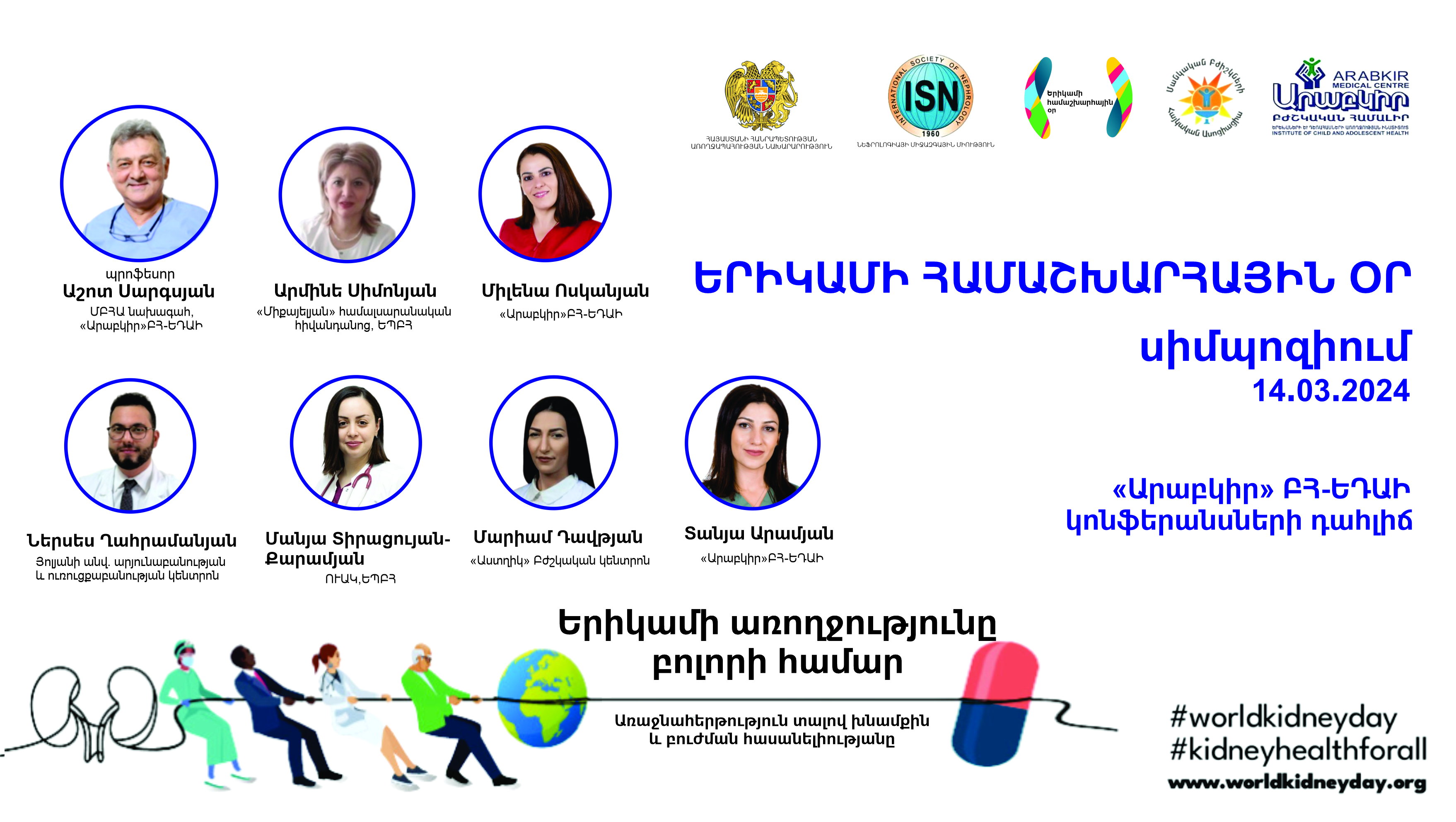
Symposia
07 March 24
Symposia
March 14: World Kidney Day.
The World Health Organization has announced this year's theme for the World Kidney Day: “Kidney Health for All – Advancing equitable access to care and optimal medication practice.”
On this occasion, medical and public communities around the world host various events to raise awareness about kidney health.
The “Arabkir” Medical Center, the Armenian Pediatric Association, the Armenian Physicians’ Association of Nephrology, Dialysis and Transplantation, in collaboration with the International Society of Nephrology, are joining this initiative. We invite nephrologists, hemodialysis specialists, and all others interested to participate in the “World Kidney Day” symposia. The symposia will be held on March 14th at 15:30 in the conference hall of the medical center, located at Mamikonyants 30. The target audience includes adult and pediatric nephrologists, hemodialysis specialists, and transplantologists.
For any questions, please email [email protected] or [email protected].
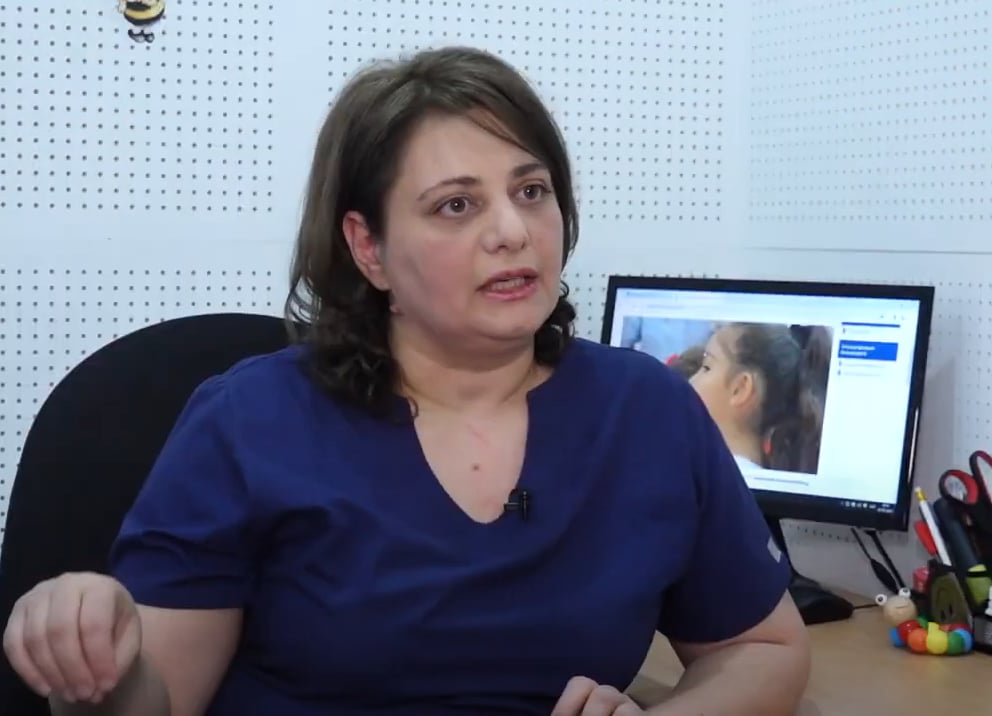
Ask the Doctor: Hearing
03 March 24
On the occasion of World Hearing Day, Nellie Mosesova, an audiologist at the "Arabkir" Medical Center, answered questions from news.am. She addressed topics such as how parents can identify hearing issues in newborns, the significance of newborn hearing screening, its implementation in Armenia and its outcomes, the causes of congenital and acquired hearing loss and deafness, available treatments for deafness, and whether screening and cochlear implants will eliminate the need for sign language.
How can parents recognize if their newborn child has hearing problems?
During a child’s early developmental stages, identifying hearing issues can be challenging. While there are specific developmental milestones, such as reaction to sounds, these may not always be evident. For example, a 1-month-old baby may not display a noticeable reaction to sound, except for perhaps focusing their gaze or a slight startle to loud, sharp noises. By around 3 months of age, babies begin to respond better to human voices, showing recognition of their mother’s voice and displaying excitement even without visual contact. Around 6 months, they start babbling and can clearly locate the source of sounds. By 1 year, we expect the child’s first words. While these milestones are important, instrumental examinations provide more accurate results. Hence, newborn hearing screening tests are conducted in maternity hospitals in Armenia during the first days of a child’s life.
What is a newborn hearing screening test?
The newborn hearing screening test is a mass screening conducted in stages. The initial stage takes place in the maternity hospital during the first days of the newborn’s life, before discharge. If hearing loss is suspected, the test is repeated, with the second stage completed no later than 2 months of age. If doubts persist, a comprehensive audiologic examination is conducted, including more complex tests to diagnose any hearing loss and determine its severity.
Since when has screening been performed in Armenia and what are the outcomes?
Newborn hearing screening in Armenia began in July 2008, initially in just 4 maternity hospitals. However, since 2018, nearly all maternity hospitals in Armenia have been equipped to perform this screening. The results align with international data, indicating that approximately one in a thousand children are born with hearing loss.
What are the causes of congenital hearing loss and deafness?
Congenital hearing loss has various causes, often involving multiple factors. Genetics is the most common cause, accounting for 30-50% of cases. It's important to note that while labeled as hereditary, both parents may have normal hearing. Complications during pregnancy, particularly infections, are also significant contributors. Certain medications taken during pregnancy can lead to hearing loss. Additionally, premature or post-term (more than 42 weeks) births can increase the risk. Other contributing factors include maternal habits and comorbidities such as diabetes or anemia, which may affect fetal nutrition.
What are the causes of acquired hearing loss and deafness?
Acquired hearing loss often results from infectious diseases such as measles and COVID-19, as well as acute respiratory infections. Certain chemotherapeutic agents used in tuberculosis treatment can also lead to hearing loss. Additionally, traumatic brain injury and prolonged exposure to loud noise, often due to increased headphone use, are common causes.
What are the available treatment methods for hearing loss and deafness?
For acute hearing loss, timely treatment within the first 5 days is crucial, as interventions after 2 weeks are less effective. Therefore, seeking medical attention promptly is essential in cases of sudden hearing loss, as delays can be critical. Alternatively, if treatment is not possible, compensatory measures can be taken. Hearing aids are commonly used for this purpose, and if ineffective, surgical interventions such as cochlear implantation may be necessary.
Is it possible to achieve the level that there is no need for a special language for deaf and mute people?
Despite advancements in technology, including hearing aids and cochlear implants, there are still cases where these methods are ineffective, necessitating the use of sign language. However, with the rapid pace of technological development, there is hope that in the near future, both speech and hearing abilities can be significantly improved.
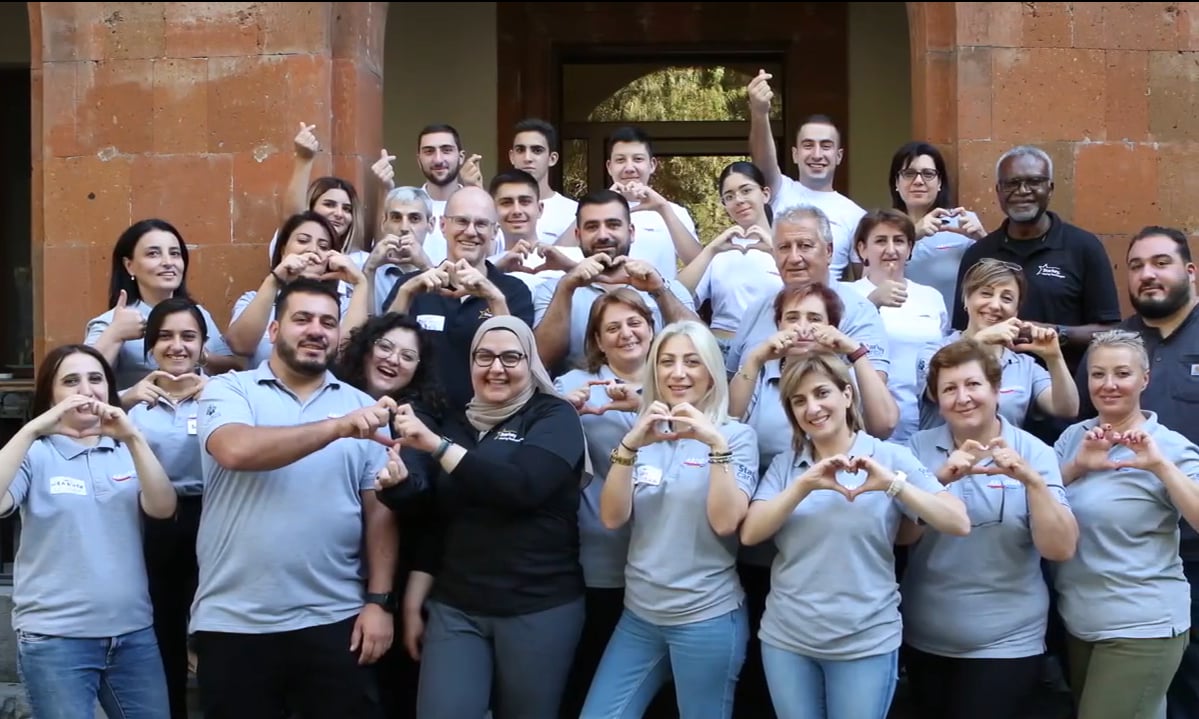
Armenia Hearing Aid Project
03 March 24
Today is March 3rd, World Hearing Day. It is a reminder to highlight the importance of hearing and taking care of it. This year's theme, “Hearing Aid for All”, as advocated by the World Health Organization, underscores the necessity of addressing hearing impairments at every stage of life, from infancy to old age.
To mark this day, we invite you to watch a video highlighting the latest mission of the Armenia Hearing Aid Project. This initiative was launched by the Los Angeles-based family of Haykuhi and Armen Kavoukjian, in partnership with the “Arabkir” United Children’s Charity Foundation. Since 2017, this project has provided high-quality digital hearing aids to thousands of individuals, including several hundred participants of the 44-Day War.
The "Armenia: Hearing Aid" Project's 2023 mission, which ran from September 11 to September 16, was tragically followed by the Azerbaijan's aggression in Artsakh on September 19 and the forced displacement of Armenians from their homeland.
HEARING THE WORLD BETTER
- I am extremely grateful. Your warm welcome and care is much appreciated! Thank you very much!
- Well done, everyone! I am deeply satisfied and grateful. Everything was well-organized, and the hospitality. It’s truly wonderful for those who appreciate it.
Countless expressions of gratitude fill the air as people depart, satisfied with the warm reception and service provided by dedicated specialists and young volunteers. They highlight the importance of attention and a caring attitude, underscoring that, in addition to receiving hearing aids, they have truly felt seen and cared for.
- The exceptional approach, attentive care, and positive attitude have left a deep emotional impact on me. I am genuinely surprised and moved by the outstanding level of service.
- They explained everything carefully.
- The 20-year-old volunteers displayed impressive organizational skills, ensuring an orderly arrangement. Everyone followed a structured process, taking turns without any disruptions.
- The service was excellent. They welcomed me with grace, and I am extremely satisfied.
This initiative didn't happen overnight. The concept for this project originated in 2008 within the family of Armen and Haykuhi Kavoukjian, residents of Los Angeles. As partners with the renowned "Starkey" company, they regularly received updates about the company's global charitable missions, specifically in providing hearing aids to those in need. Recognizing the need in Armenia, they took action and launched their inaugural mission in 2017, partnering with the ARABKIR United Children’s Charitable Foundation and the ARABKIR Medical Center. Over three consecutive years, the Starkey team, under the leadership of founder Bill Austin, collaborated with the Kavoukjians and numerous volunteers, bringing the gift of hearing to thousands of individuals across Armenia, including Yerevan, Gyumri, Vanadzor, and Artsakh.
In 2020, as the global COVID-19 pandemic swept across the world, "Starkey" temporarily halted its project activities. Despite the ongoing need, particularly in Armenia where many individuals returned with hearing impairment from the 44-day war in Artsakh, the Kavoukjians swiftly redirected their efforts. This time, their focus was on aiding war participants by supplying high-quality hearing devices. The years 2021 and 2022 saw a dedicated emphasis on supporting those affected by the conflict.
Lusine Babayan - Country Coordinator, “Armenia Hearing Aid” Project - In 2020, we equipped 240 individuals, predominantly military personnel, with cutting-edge digital hearing aids featuring the latest technologies.
Once again in 2023, the Kavoukjian family, alongside volunteers from Starkey Cares and friends from Los Angeles, is in Armenia for the next mission. This time, the project specifically targets individuals who, for various reasons, were not part of government or other support initiatives.
Lusine Babayan - Country Coordinator, “Armenia Hearing Aid” Project - The primary concern we've identified is with individuals who do not have a recognized disability but are in need of hearing aids. Furnishing them with these devices has the potential to prevent job loss, boost social engagement, enhance their overall quality of life, enable participation in various activities, and assist in overcoming numerous challenges.
Narek Mkrtchyan, the Minister of Labour and Social Affairs visited the mission site on the first day. He expressed high appreciation for the support extended to the country and its citizens through such initiatives.
Narek Mkrtchyan - Minister of Labour and Social Affairs of the RA - Significant efforts are currently underway to support individuals with hearing impairment, providing our citizens with access to cutting-edge devices utilized globally. This initiative is particularly noteworthy as it caters to specific target groups that may be excluded from state support programs. In our context, we have clearly defined target groups eligible for state support projects, making this initiative crucial in addressing a specific need. The project effectively complements existing state programs, with dedicated efforts over the years and the pivotal role played by the "Arabkir" medical center under the leadership of Mr. Babloyan. I extend my best wishes for the success of this initiative. It's essential to recognize that this goes beyond charity; it's about creating knowledge and value. This not only contributes to new infrastructures but also nurtures new knowledge, enabling our specialists to advance and elevate the field.
The dedication and care demonstrated by the Kavoukjian family and all supporters of the project are truly impressive, according to Ara Babloyan, the partner of the project in Armenia and the founder of the “Arabkir” United Children’s Charitable Foundation. They not only provided the idea but also secured the finances and actively participate in all missions, personally fitting the devices and giving the gift of hearing to our people.
Ara Babloyan - Founder, “Arabkir” United Children’s Charitable Foundation - What I appreciate most about the Kavoukjian family's approach and their organization is the lack of formality; it's all about substance. Our perspectives align, as we, too, set our goal with an emphasis on meaningful content right from the beginning. I'm delighted that we could come together and collaborate on this shared commitment.
Between September 11 and 16, close to 1000 individuals were equipped with hearing aids, with more than 100 of them being high-quality digital devices. A significant number of these devices were provided in pairs for dual-sided wearability. The recipients came from various locations, including Yerevan, Gyumri, Vanadzor, and other cities and villages. Additionally, beneficiaries from Artsakh, who were in Armenia during that period and unable to return due to the blockade, were also served. The project collaborated with provincial administrations and municipalities to facilitate the smooth transfer of beneficiaries.
- They called me, and then informed my husband about the day and time, so we immediately left our jobs and came from Gyumri to Yerevan.
- I have a somewhat unusual sensation, but they reassured me that it's normal. They advised me to wear it and allow myself time to adapt.
- It comes with an application which is great. You can adjust the volume, lower or raise it and also check the battery.
- My previous device was broken, and our nurse told me about this project. She said I was included, so I came from Russia to receive the devices I really need.
The role of volunteers is particularly crucial in this endeavor. Volunteers are individuals from Palestine, Great Britain and the USA as well as students from various universities of Armenia.
Volunteer - Here, we provide consultations and explain how to use and take care for the hearing-aid. We have a sample device and a box to illustrate proper care and cleaning.
Volunteer - I am a physician and for me the primary reward is a profound personal fulfillment. At the day's conclusion, the knowledge that you've positively impacted people's lives, especially when you witness their satisfaction, makes all the efforts worthwhile.
Volunteer - I’ve participated in many volunteering programs, but this one is different because we’re helping the elderly. Doing everything we can to ensure they can hear brings us immense joy.
- They are incredibly caring. I won't forget it; it will remain in my memory forever. The heartfelt welcome I experienced has filled me with genuine gratitude, and I'm even moved to tears. The surrounding warmth seemed to enhance my ability to hear.
This large-scale annual initiative becomes a reality through the dedicated efforts of volunteers and donors committed to assisting individuals with hearing impairment in Armenia. The primary financial support for this year’s mission was generated during a charity dinner organized by the “Armenia: Hearing Aid” Project on March 3, on the World Hearing Day.
Haykuhi Kavoukjian - Founder, “Armenia Hearing Aid” Project - We selected a venue with historical significance, where Charlie Chaplin once got married. Connecting the Silent film era with hearing, our gala evening was themed “Silent Film”, resulting in a successful fundraiser that received significant support. The Armenian community in Los Angeles believes in and supports us tremendously. It’s because of this fundraiser that we decided to provide high-quality digital devices to the 30-50-year-old Armenians, enabling them to seek employment, enhancing their quality of life.
The Starkey Foundation's initial goal was to empower us with knowledge to carry on their crucial work. Today, they take pride in our accomplishments. In the spirit of the English saying "flying solo," signifying readiness to navigate independently, we are now soaring on our own, and for that, we express our gratitude.
The “Armenia: Hearing Aid” Project team stands alongside our compatriots, always ready to support individuals with hearing impairment in improving their quality of life by enabling them to hear the world much better.

March 3rd: World Hearing Day
03 March 24
On the eve of the World Hearing Day, the news team of the Public TV Company visited the Speech Development Center at the "Arabkir" Medical Center, which caters to 40 children with hearing impairment attending classes 4 times a week.
Thanks to the dedicated work of the audiology service team, including doctors, audiometrists, audio therapists, art therapists, psychologists, and of course, parents, the children learn to speak and successfully integrate into public schools.
- What is your name?
- Narek.
- How old are you?
- Seven.
Narek is currently in the first grade and has profound (Level 4) congenital hearing loss. He visited the Speech Development Center at the “Arabkir” Medical Center to monitor his progress.
Suzanna Harutyunyan, Narek’s mother, shares: “We first heard Narek speak his first words, “mama”, “papa”, “ami” (red - “karmir” in Armenia), and “atach” (green - “kanach” in Armenian), when he was 4.5 years old. About a year later, following Roza’s advice, I began keeping a diary to track his progress, writing down the words in order. When I revisited the diary a year later on the same date, I was surprised to find out that Narek had learned 270 new words.
There are many guests gathered at the Speech Development Center on World Hearing Day, including former students who came to express their gratitude in person.
Among them is 7-year-old Mariam, reciting a poem. She has already decided to become a doctor - a dentist. At first glance, there are no signs that she has ever experienced hearing or speech difficulties.
Audiologist Marine Grigoryan provides insight, “Mariam was diagnosed a bit later, but with early intervention and the use of prosthetics, significant progress has been made in improving the quality of her speech.”
Early diagnosis and timely interventions play a crucial role in overcoming challenges and facilitating social integration.
Marine Grigoryan further emphasizes: “Mariam’s case exemplifies the importance of early intervention, from identification and diagnosis to the provision of prosthetics and specialized classes.”
Thanks to these efforts, Mariam now exhibits speech development comparable to her peers, highlighting the positive impact of early detection and appropriate interventions on a child's development.
Dr. Nelli Mosesova emphasizes: “According to WHO data, approximately 5% of the global population experiences various forms of hearing impairment, a condition that is particularly prevalent among children. In fact, it ranks as one of the most common pathologies even among newborns, affecting roughly one in a thousand individuals on average.”
While hereditary factors account for 30-50% of cases of hearing loss, it's important to note that children with hearing impairments can also be born to parents without any prior history of such conditions.
Dr. Nelly Mosesova explains, “There are various causes of hearing loss, with many cases attributed to conditions like acute respiratory infections or other illnesses, often resulting in temporary impairment.
The newborn hearing screening program was initiated in Armenia in 2008 and has been fully implemented nationwide since 2018. With advancements in modern medicine, there are many opportunities available to enhance children's hearing. To preserve the vital sense of hearing that connects us to the world, it is crucial to prioritize our health.
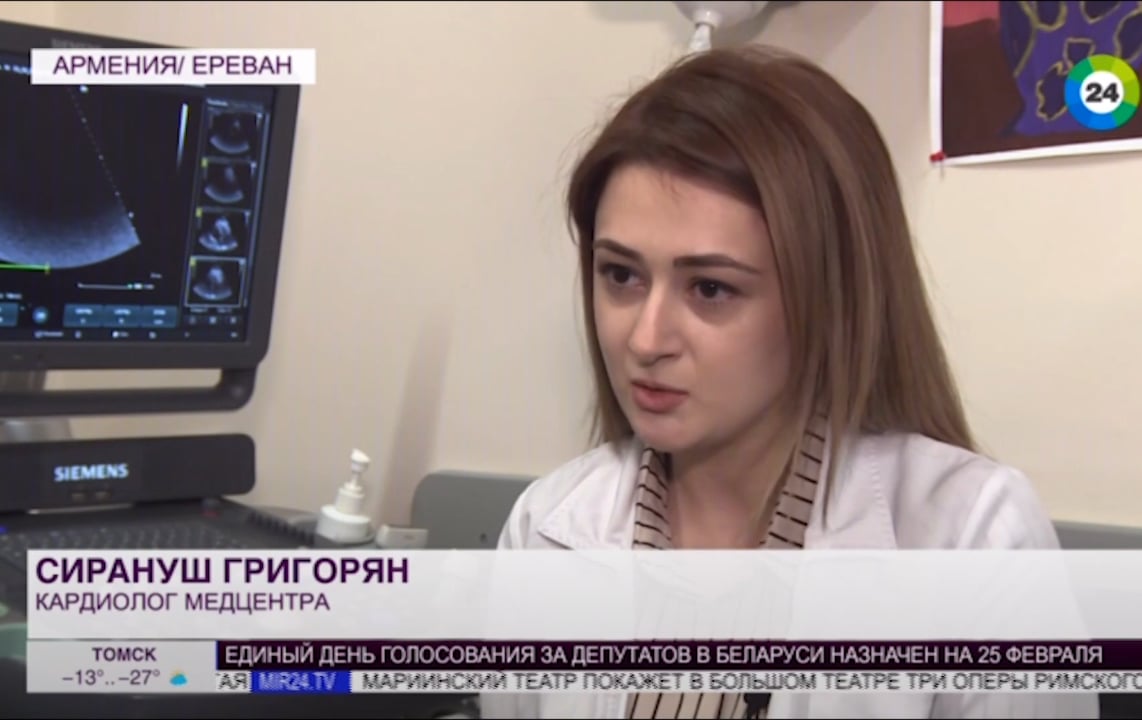
Life with a Transplanted Heart
01 March 24
The “24” news program of “Mir” TV company recently covered the topic of organ transplantation, highlighting the case of Yeghishe Khachatryan, who underwent a heart transplant. Yeghishe received his transplant surgery in Minsk and is currently receiving follow-up care at the “Follow-up Care Department for Organ Transplanted Patients” at “Arabkir” medical center. Reflecting on his experience, Yeghishe shares, “Thirteen years ago, I was given a second chance at life. The heart transplant was a turning point for me.”
After undergoing laboratory tests, a visit to the cardiologist, discussions about self-awareness, ultrasound of the heart, ECG, and other procedures every three months are part of Yeghishe Khachatryan’s routine. He holds a unique status as the sole individual in Armenia who has undergone a heart transplant.
Cardiologist Siranush Grigoryan remarks, “Yeghishe's condition remains stable. He diligently adheres to his appointments, medication regimen, and follows all medical advice. He maintains a healthy lifestyle, abstaining from harmful habits. It's essential for him to consume foods that promote lower cholesterol levels, engage in regular outdoor walks, and maintain physical activity."
In 2004, Yeghishe Khachatryan began experiencing symptoms such as chest pain, weakness, and shortness of breath, leading to a diagnosis of a heart attack. The second incident occurred 4 years later, but despite treatment in cardiology hospitals, his condition did not improve. After numerous consultations with medical professionals, it became evident that his heart and blood vessels were extensively damaged, rendering procedures such as stenting or shunting ineffective. The only viable solution was a heart transplant, a procedure not available in Armenia.
Reflecting on his journey, Yeghishe recalls, “By 2012, I was reliant on an oxygen machine for breathing. My brother accompanied me to Novosibirsk, where consultations confirmed that a transplant was my only hope. We were directed to a hospital in Minsk, where I was placed on the transplant waiting list. Within 15-20 days, a donor match was found - a thirty-year-old young man who tragically lost his life in a car accident.”
The procedure was conducted by the renowned cardiac surgeon, Doctor of Medical Sciences, Professor Yuri Ostrovsky. By that time, approximately 100 heart transplants had already been performed at the Minsk Cardiology Center.
Reflecting on the procedure, Professor Ostrovsky states, “The technology was well-developed, and we had accumulated significant experience. The decision to proceed with the transplant was based on the patient's condition. However, selecting a suitable donor-transplant match always presents challenges. Factors such as weight, height, blood type, and compatibility tests, including Cross Match, are considered. We ensured that all criteria were met before proceeding with the transplant.
The total cost of the surgery, tests and medications amounted to $55,000, which was covered by contributions from Yeghishe's brother and friends.
Expressing his gratitude, Yeghishe remarks, “Of course, I remember Yuri Petrovich. He is a kind person. I am thankful to him, the entire medical team, our doctors who continue to monitor my health, my brother, and to all those who helped. Having experienced this journey, I urge my fellow citizens to reconsider their views on organ donation. By consenting to organ donation from deceased relatives, many lives can be saved.”
In Armenia, only kidneys, liver, corneas are currently eligible for transplantation, with donors limited to close relatives. According to the Organ and Tissue Transplantation Act, individuals can be considered potential donors after death if their family members consent to organ retrieval. However, as of yet, there have been no instances of post-mortem organ donation. To address this, the Ministry of Health is working on changing the law to allow organs to be donated after someone passes away and to create a list of people waiting for transplants.
Elen Nazaryan, head of the Hemodialysis Department at the “Arabkir” Medical Center, underscores the significance of these proposed changes, stating, "Reforming the law would enable the establishment of a repository of posthumous donor organs, facilitating heart, lung, pancreas, and additional kidney transplants.
Currently, Armenia accommodates 1,100 dialysis patients, including 400 awaiting kidney transplants. The full implementation of a transplant recipient registry hinges on the integration of all major medical centers into the electronic healthcare system.
Experts contend that the adoption of posthumous donation protocols would significantly enhance the prospects of saving lives. Later in the evening, Yeghishe Khachatryan will gather with his family to commemorate his "second birthday" and express gratitude to those who bestowed upon him a renewed lease on life.
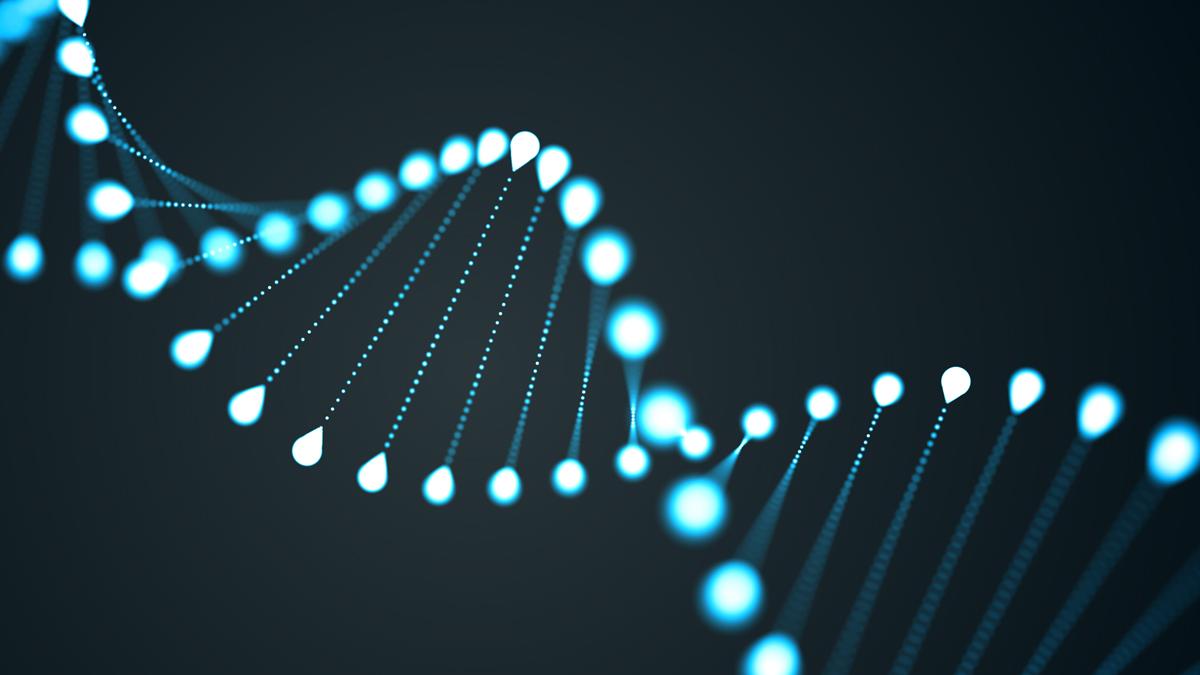
Rare Disease Day
29 February 24
February 29 is designated as Rare Disease Day in the medical calendar. According to the World Health Organization, diseases occuring in one in 2000 people or less are classified as rare. Globally, approximately 300 million people are affected by rare diseases, with medical literature documenting around 7,000 types, 80% of which have a genetic origin. Despite the common occurrence, diagnosis of rare diseases often takes an average of 4.8 years. This underscores the importance of early and accurate diagnosis, which is this year's theme, along with increasing treatment possibilities.
Rare diseases are also diagnosed periodically in various departments of the "Arabkir" medical center, including neurology and rheumatology. In Armenia, the frequency of such cases corresponds to patterns seen worldwide. Our specialists prioritize collaboration with international partners in diagnosing and managing rare diseases, striving tirelessly to enhance the life and quality of life of each patient.
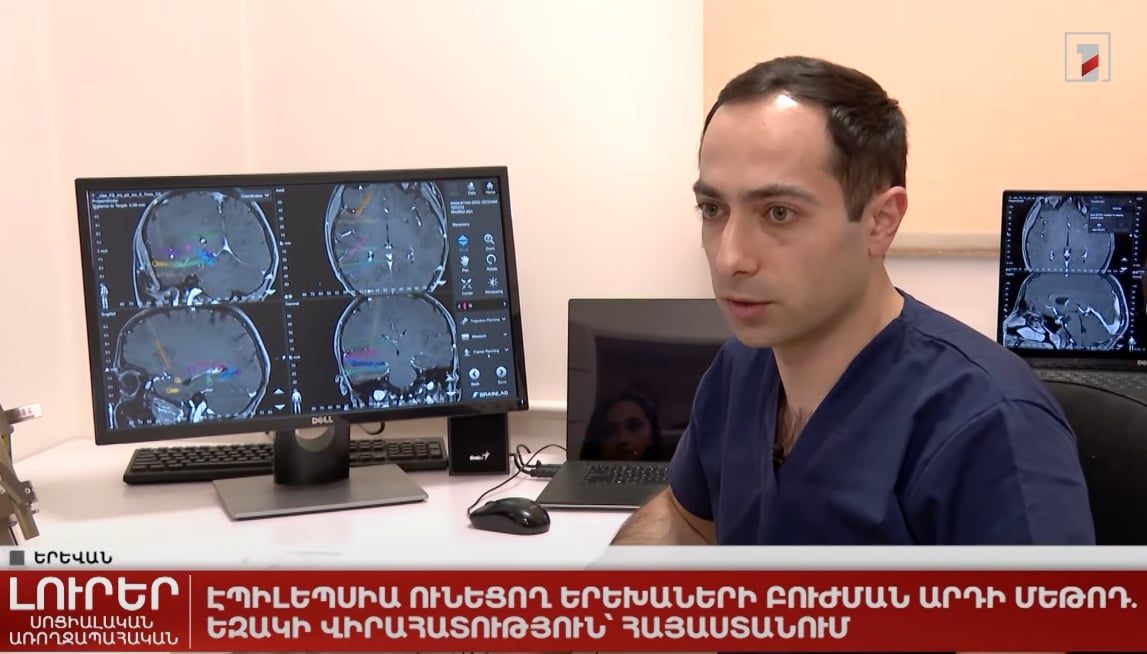
Epilepsy: Stereo-EEG
26 February 24
The Public TV has highlighted the adoption of a less invasive surgical method for diagnosing and treating children with epilepsy at the "Arabkir" medical center. This advancement in modern medicine, stereotactic electroencephalography, enables precise identification and removal of epileptogenic foci, leading to significant improvements in patients’ quality of life.
Niko Arzumanyan, the head of the Neurosurgery service at the “Arabkir” MC-ICAH, explains, “Through the sequential recording of brain electrical activity from each microelectrode of the implanted electrodes, relevant specialists identify the foci responsible for epileptic seizures in the patient during the study.”
Stereo-EEG was performed for the first time on a child with epilepsy in Armenia. This method is considered one of the most modern and complex approaches to treating this condition. It involves a minimally invasive intervention, allowing for the precise identification of the epileptic focus by gathering information about the activity of brain cells.
Niko Arzumanyan explains, “When a specific epileptogenic zone is identified, we immediately conduct radiofrequency ablation of the indicated areas without any incision or damage to the skull. This procedure targets the identified foci, offering patients the opportunity to alleviate their epileptic seizures. For most patients, stereo-EEG provides crucial information, enabling us to identify the epileptogenic zone accurately. Subsequently, we perform open surgery to achieve optimal results.”
Biayna Sukhudyan explains, “Following the intervention, the patient, who previously experienced seizures monthly, remained seizure-free for a month. This outcome indicated the correctness of our decision, and we recognized that complete cessation of seizures was not achievable after the ablation. Another month elapsed before we performed surgery on the patient and surgically removed the identified focus.”
Armenian doctors, in collaboration with Bulgarian colleagues, conducted a stereo-EEG procedure on a 14-year-old child. The doctor elaborates that the intervention is facilitated through the use of a stereotactic system.
Neurosurgeon Niko Arzumanyan further explains and demonstrates, “The device features numerous coordinates and angles, aiding us in pinpointing the exact location for electrode insertion into the brain. A 1.5mm incision is made in the skin, followed by a 2mm diameter incision in the skull, through which electrodes are carefully placed deep into the corresponding brain regions.”
An epileptology dispensary operates within the "Arabkir" medical center, where approximately 3,800 patients under the age of 18 are registered.
Biayna Gagikovna explains, “It's important to note that surgery is not suitable for all epilepsy patients. Approximately 70% of patients can be effectively treated with medication, while around 30% have drug-resistant forms of the condition. Hence, only about 50% of patients are eligible candidates for epilepsy surgery. Epilepsy, being a chronic disease, can manifest in various ways, from motor to emotional seizures.”
Doctor Sukhudyan elaborates, “In childhood, we primarily encounter hereditary forms of epilepsy, although there are several acquired causes as well. These include infantile cerebral palsy, fetal asphyxiation at a young age, various infectious diseases affecting the brain, tumor diseases, and immune disorders. In other words, there can be numerous underlying reasons.”
If a person is having seizures in a public place, citizens often take the wrong steps when providing first aid, according to the doctor.
Doctor Sukhudyan advises, “It's crucial to avoid taking incorrect actions when providing assistance. Refrain from intervening, attempting to open the patient's mouth, pulling their tongue out, or trying to revive them forcibly, as such actions can be harmful. Instead, the first step is to gently turn the person onto their side and promptly call for emergency assistance.”
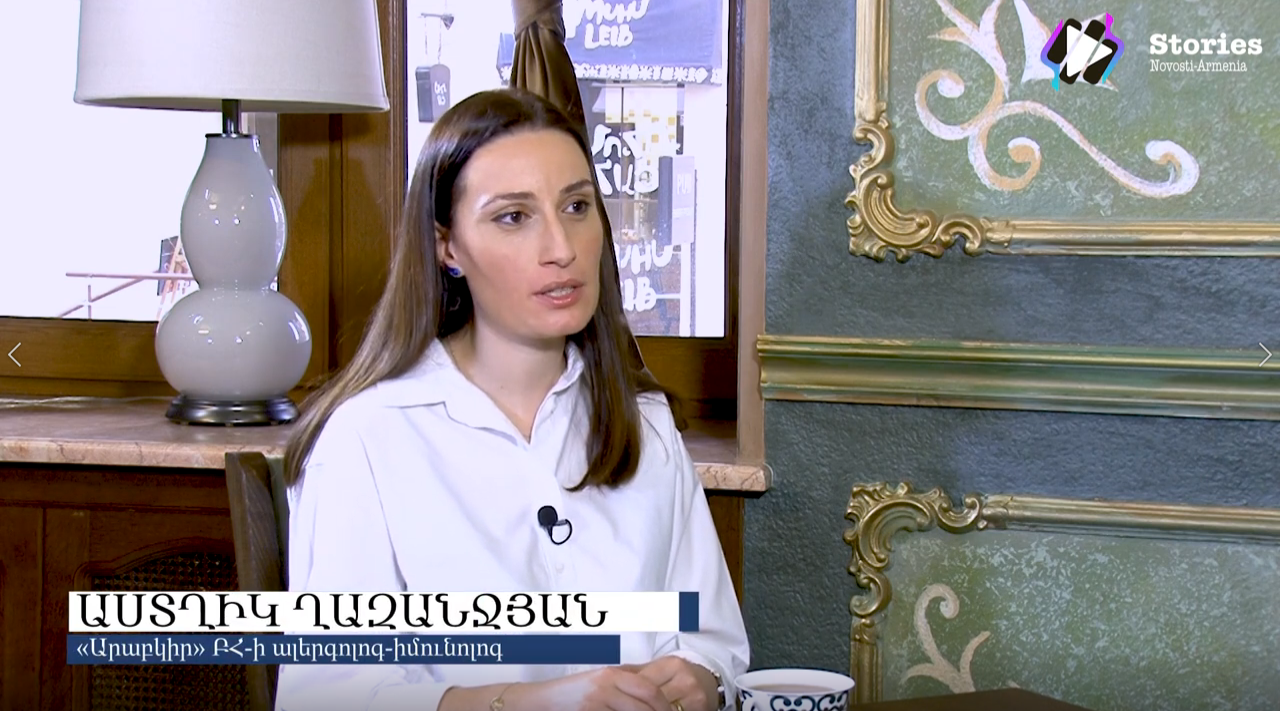
About Immunity
15 February 24
Novosti-Armenia Stories invited Astghik Ghazanjyan, an allergist-immunologist from the Respiratory Medicine, Allergology and Immunology service at the “Arabkir” medical center, to discuss immunity and dispel myths and misconceptions surrounding it.
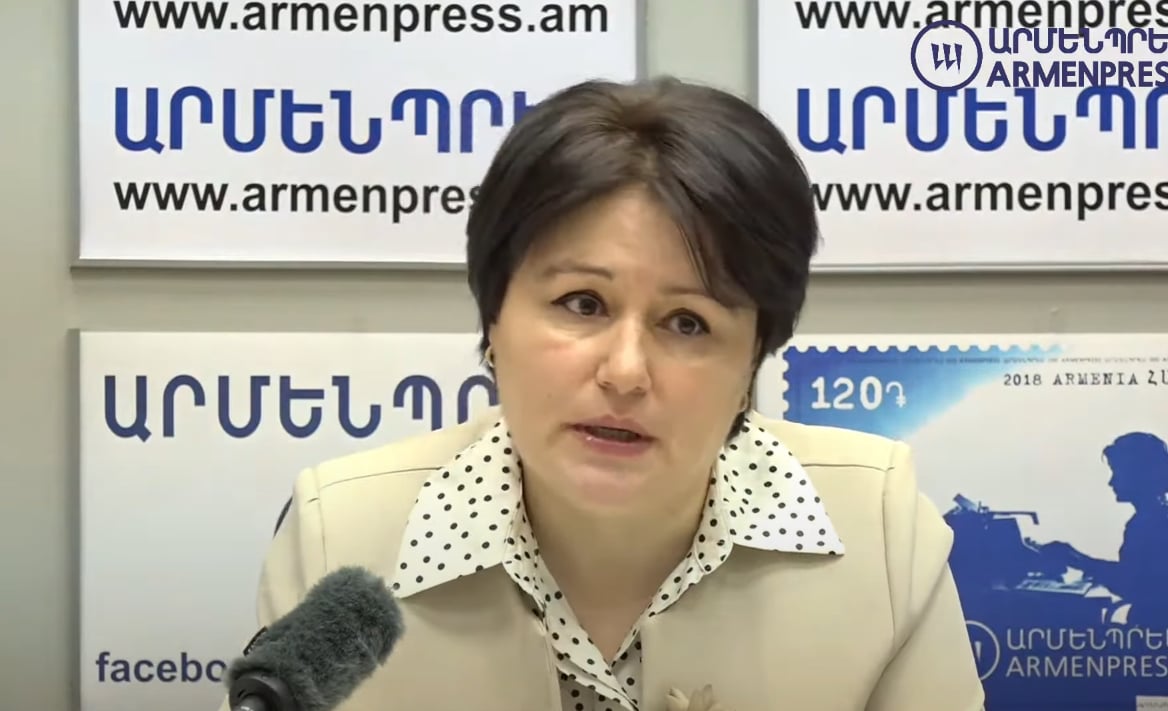
Healthy lifestyle courses in schools
14 February 24
Marina Melkumova, pediatrician and Adolescent Health Program Coordinator at “Arabkir” MC-ICAH, recently participated in a press conference hosted by “Armenpress” news agency. The conference focused on the activities of healthy lifestyle courses in schools, their content, and expected outcomes.
During the conference, Dr. Melkumova highlighted that the course topics aim to promote personal development, first aid skills, and the ability to avoid harmful effects. For more details, please follow the link.

4th Armenian Oncology Congress
06 February 24
Watch Professor Ara Babloyan’s speech from the opening ceremony of the 4th Armenian Oncology Congress on News.am.
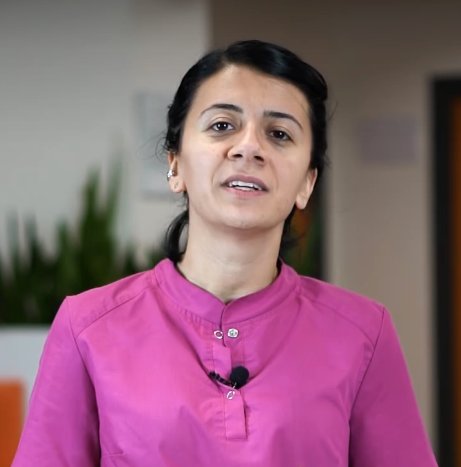
Thermometers and temperature measurement in children
02 February 24
As a part of the #OPENFamilyEducation initiative, Knarik Sukiasyan, one of our pediatricians, has shared interesting facts about thermometers and temperature measurement. Listen to the specialist and remember that taking your child’s body temperature using your palm is simply wrong.
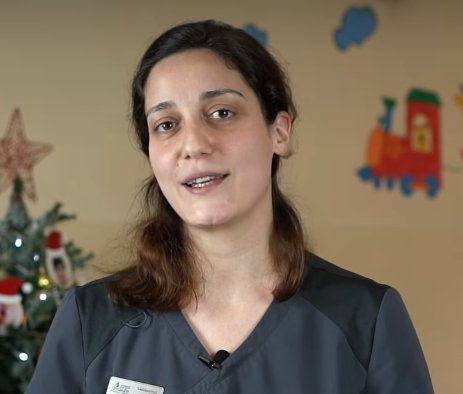
Respiratory syncytial virus
01 February 24
As part of the #OPENFamilyEducation project, Anna Arakelyan, a pediatrician from the Department of Children under 1 year old, has shared important information for parents regarding the respiratory syncytial virus. She discussed its signs and the necessary actions to take if those signs are noticed.
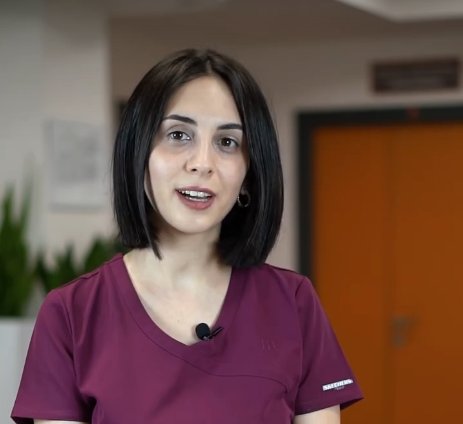
Acute laryngotracheitis or “false croup”
31 January 24
The specialists of the “Arabkir” medical center have joined the #OPENFamlilyEducation project to provide advice, raising parent awareness, and assisting with quick and correct orientation in case their child has health issues.
Pediatrician Hasmik Vardanyan will discuss acute laryngotracheitis, commonly known in Armenia as “false croup”.
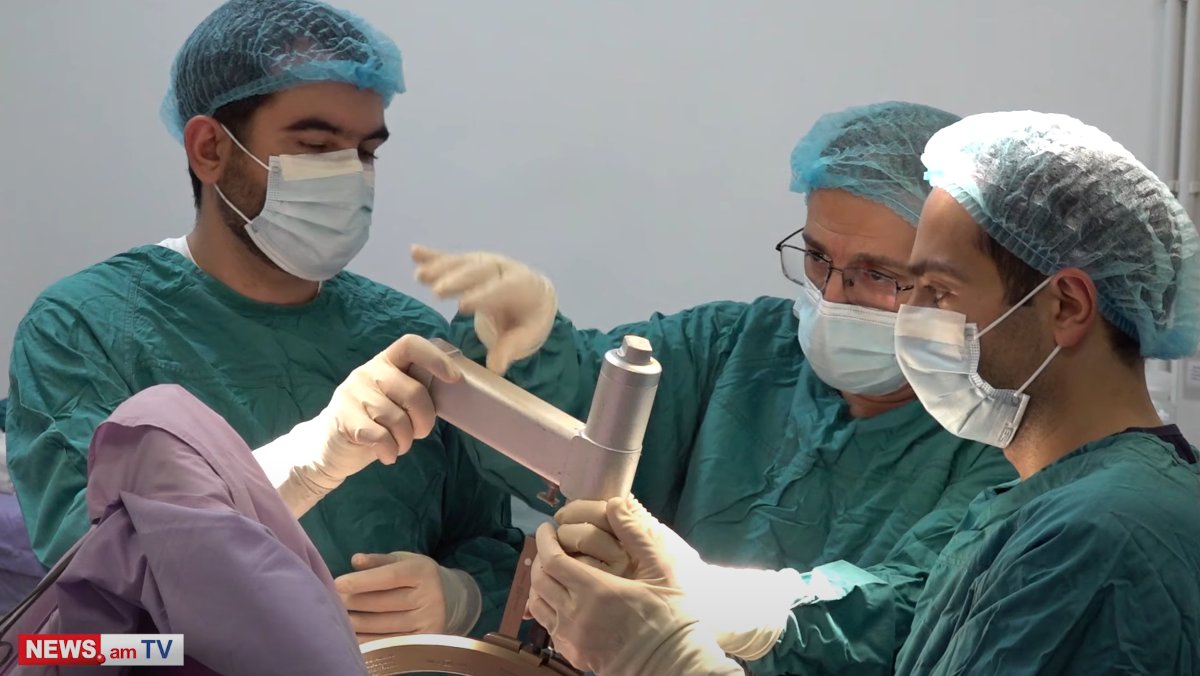
First time in Armenia: Stereoelectroencephalography (sEEG)
23 January 24
The team of neurosurgeons and neurologists at the “Arabkir” Medical Center is introducing modern methods for diagnosing and treating epilepsy in Armenia. Collaborating with colleagues from the University Hospital “St. Ivan Rilski” in Sofia, Bulgaria, our specialists recently performed stereo-EEG, a unique intervention that precisely identifies the source of epileptic seizure activity and facilitates coordination for subsequent surgical treatment.
Further details can be found in the video on news.am.
14-year-old Eric, who has been dealing with drug-resistant epilepsy since childhood, now has an opportunity to overcome seizures. He underwent a modern examination at the “Arabkir” medical center, specifically stereo-EEG. This diagnostic and, in some cases, treatment method, accurately identifies epileptic seizure foci in the brain - a procedure performed for the first time in Armenia.
Unlike regular electroencephalography, stereo-EEG is a minimally invasive surgical procedure. Special electrodes are placed in deeper areas of the brain using a stereotactic system, recording epileptic activity.
“Firstly, stereo-EEG is primarily considered a diagnostic method. However, based on its results, a minimally invasive surgical treatment of epilepsy can be undertaken. After placing the electrodes, the neurological team examines all contacts. Upon identifying relevant epileptogenic foci, a discussion is held to determine whether to proceed with coagulation or the surgical removal of the area,” says Sevak Badalyan, a neurosurgeon from the “Arabkir” MC.
Eric’s case presented a unique challenge: despite undergoing various examinations, the epileptogenic focus could not be identified. To achieve accurate diagnosis, 12 electrodes have been placed in his brain, and specialists are monitoring the child’s brain electrical activity to decide the course of further treatment.
“The reason we opted for stereo-EEG in this patient was due to uncertainty about the origin of epileptic activity. While an epileptic focus was visible on the MRI, the description, videotape and EEG did not align. Clinicians entertained doubts that this identified focus was the one to be removed. Therefore, electrodes were placed not only in that focus but also in anterior areas that appeared more suspicious of causing the clinical picture of the seizure.By the second day after electrode placement, we were convinced that our hypothesis was correct. The identified area had no connection with Eric’s epilepsy, and seizures were originating from slightly anteriorly located areas on the same side. This allows us to plan the upcoming surgery accurately” says Biayna Sukhudyan, head of the Neurology and Epileptology service at the “Arabkir” MC.
The first stereo-EEG at the “Arabkir” Medical Center was conducted in collaboration with Bulgarian specialists. According to the pediatric neurologist Petia Dimova from Sofia, they have been working in partnership with Biayna Sukhudyan and the Neurosurgical team at the “Arabkir” MC for 15 years.
“It’s a wonderful team. Although this is the first case, they are already well-versed and capable of conducting similar procedures in the future, thereby assisting patients in Armenia. This hospital, under its management, is dedicated to making all modern diagnostics and treatment methods accessible to citizens, particularly children, in Armenia” says Petya Dimova, a pediatric neurologist from Bulgaria.
The specialists are currently monitoring the child’s spontaneous seizures and conducting special stimulation to identify contacts for ablation. While small foci can be addressed with a temporary effect, the ultimate solution for treating the disease involves the surgical removal of the epileptogenic focus.
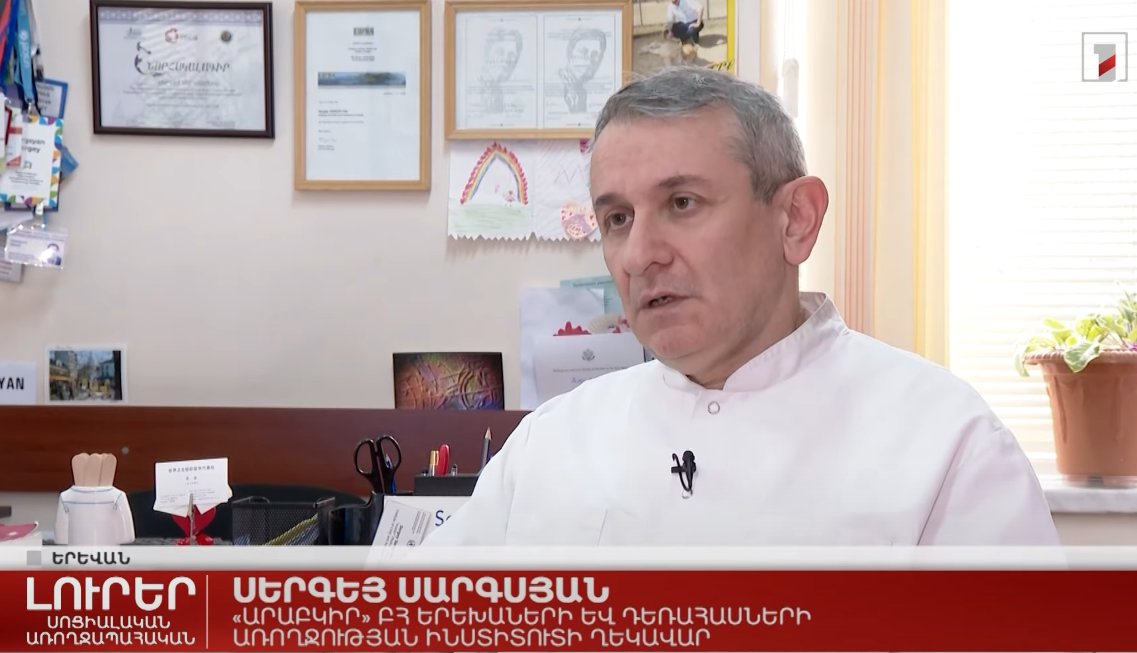
FMF: No Cases of Kidney Amyloidosis
16 January 24
Pediatrician Sergey Sargsyan, the head of the Institute of Children and Adolescent Health at the "Arabkir" Medical Complex, addressed questions from the Public Television Company "News" regarding Periodic disease / Familial Mediterranean Fever (FMF), a genetic condition prevalent among Armenians and relatively common in our population.
Thanks to the dispensary control service established decades ago, cases of complications related to the disease and its consequential kidney failure have significantly decreased from 16% to 0 among children under the age of 18 with FMF.
Approximately 3600 children diagnosed with FMF are currently undergoing treatment in Armenia, including compatriots under the age of 18 residing in other countries with the same diagnosis. The doctor emphasizes that approximately 400 children receive this diagnosis annually, with a noticeable upward trend in recent years.
According to pediatrician Sergey Sargsyan, the head of the “Arabkir” Medical Center-ICAH “Periodic disease” is a hereditary disorder. Although some may refer to it as the “Yerevanian disease”, it is unrelated to the city of Yerevan. In the international classification, it is known as “familial Mediterranean fever”, affecting people from this region, including Armenians, Sephardic Jews, Arabs, and Turks, who naturally inherited the gene through centuries of mixing with different populations.
The disease can manifest with recurrent fever, abdominal pain, and may even lead to kidney failure. It is prevalent among the Armenian population, with most cases developing before the age of 20, depending on the type of gene.
Dr. Sargsyan explains, “One in five individuals has one gene, but a single gene is insufficient. For the disease to develop, two genes—maternal and paternal—must combine, in most cases.”
While in the 1990s, approximately 16% of children in our country experienced kidney complications before reaching adulthood, the current scenario has changed.
Sargsyan details, “The discovery of the gene, conducted by the Center of Genetics in Armenia, along with subsequent organizational efforts and the implementation of a unique ambassadorial model, where patients visit the center for treatment and check-ups, has led to a remarkable reduction. Today, I can report that the initial 16% has decreased a hundredfold. We now have unique cases where children develop kidney complications, at least in infancy.
The Children's Republican Center for Periodic Diseases at the “Arabkir” Medical Center provides treatment for children aged 0-18 years under the state order.
Sergey Sargsyan adds, “People over the age of 18 can also receive appropriate medication and undergo monitoring at the regional health center.
Various treatment and control models are available. The crucial aspect is to diagnose the disease promptly and at its earliest stage.
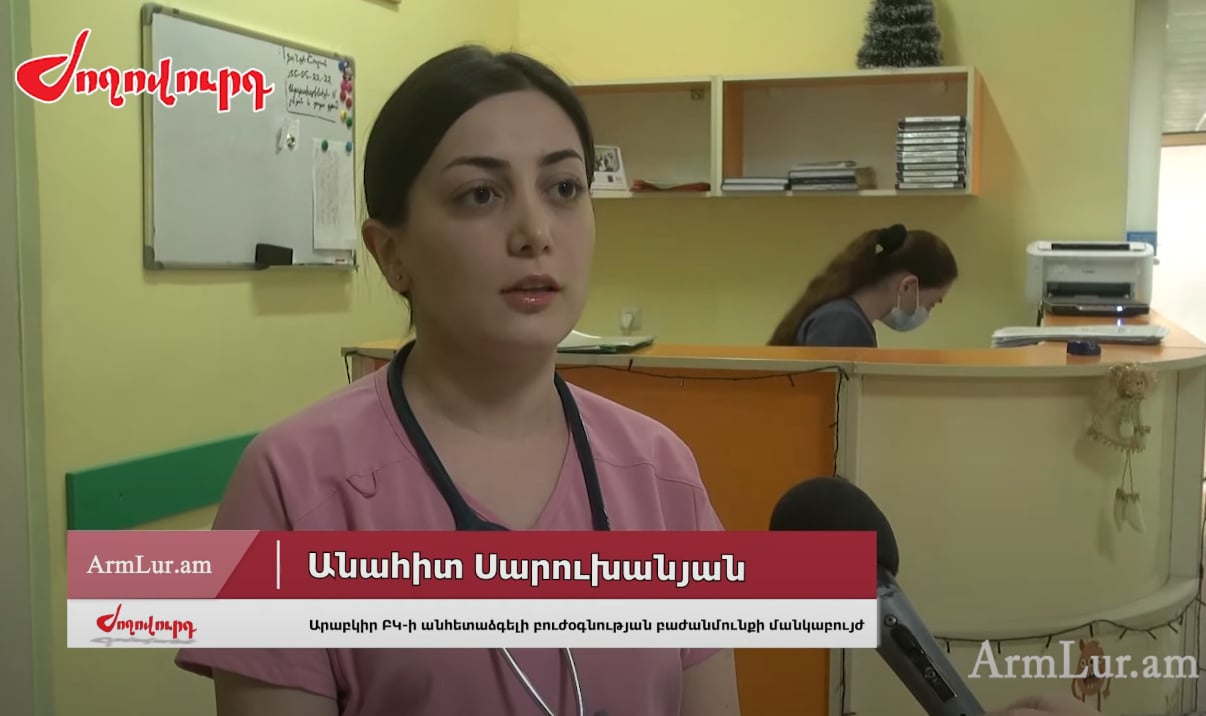
Acute Respiratory Viral Infections
15 January 24
Despite facing a surge in acute respiratory infections, our doctors have still found time to respond to journalists from various media outlets. The objective is to empower parents with information, ensuring that decisions concerning their child’s health are sensible, accurate and timely.
Anahit Sarukhanyan, a pediatrician from the Reception and Emergency Department, addressed questions from “Armlur”.

ARI: prevention and management
11 January 24
The subject of acute respiratory infections was addressed by Public TV. Meri Marandyan, a pediatrician from the Reception and Emergency Department at the “Arabkir” medical center, provided answers to inquiries.
Listen attentively, stay informed and learn to effectively manage such situations with the appropriate steps.
“Arabkir” Medical Center is currently experiencing a significant surge of visitors. The high activity in admissions is attributed to acute respiratory infections typical of the season.
Pediatrician Mary Mardanyan explains, “Most children are admitted already desaturated, exhibiting a bronchiolitis pattern, which is considered as 100% indication for admission to the hospital. This influx is due to the fact that a large percentage of cases involve babies who are oxygen-dependent and require intensive monitoring in hospital conditions.”
The medical center receives almost 120-125 patients daily, with influenza types A and B being prevalent among children.
The doctor advises, “I recommend that all children exhibiting symptoms characteristic of the virus, their parents should, first of all, contact the local pediatrician. The pediatrician will assess the child's condition and, if necessary, provide a referral for the hospital treatment. This approach will reduce both hospital referrals and the primary care/hospital stay of those children who really need us.”
While October to May is considered the season for acute respiratory infections in Armenia, there has been a noticeable increase in morbidity in recent days.
Romella Abovyan, head of the Department of Epidemiology of Infectious and Non-Infectious Diseases at the National Center of Disease Control of the Ministry of Health of the Republic of Armenia, states, “We are observing cases of influenza A with all its subtypes, circulating influenza B, and other respiratory viral infections such as parainfluenza, adenovirus, respiratory-syncytial (RS) virus, rhinovirus. Additionally, there are recorded cases of co-infections, where a person has multiple viruses simultaneously, like adenovirus with rhinovirus. This naturally complicates the clinical course further. As of the 8th January, we have recorded 1,547 cases in primary care, with 1,105 cases among 0-18-year-olds, constituting 71% of the total cases”.
In other words, compared to the previous day, the number of admissions increased by 1.8 times, compared to the same day last year, it rose by 4.9 times. Daily analysis revealed an increase in both emergency calls and hospitalizations.
Mrs. Abovyan reports, “There were 216 calls, of which 61 were among 0-18-year-olds, constituting 36% of total cases. Additionally, 24 emergency calls for pneumonia were registered, with 3 among 0-18-year-olds.”
As of January 8, 749 patients were hospitalized, marking an increase of 170 from the previous day. Abovyan attributes the sharp increase to people not seeking medical care during weekends.
Romella Abovyan emphasizes, “The Ministry of Health urges people to get vaccinated against the flu. This helps to make the disease easier to bear even if infected, and it’s important to avoid crowded places.”
In case of symptoms, avoid sending children to school and preschool, and consider wearing masks.

Questions about ARI
10 January 24
Tamara Chagharyan, a pediatrician from the Reception and Emergency Department at the “Arabkir” medical center, responded to inquiries from “Epikentron” regarding acute respiratory infections.
In winter, acute respiratory viruses become active, with high infectivity primarily through the droplet route. Children constitute the most vulnerable group, accounting for 70% of infected individuals, according to the National Center for Disease Control and Prevention.
Especially during holidays, medical institutions operated with an overcrowded schedule. Viruses tend to spread, particularly during New Year's Eve visits to each other's homes.
Pediatrician Tamara Chagharyan notes, “We have a significant increase in respiratory virus cases. While I wouldn't assert that this year's morbidity is higher than previous years - December, January, and February have always been burdened with acute respiratory viruses. Currently, diseases caused by the influenza A subtype virus are prevalent. Additionally, we are seeing frequent cases of respiratory syncytial virus infection. Though less common among children, confirmed cases of Coronavirus infection are also present.
Common symptoms of the virus include fever, cough, runny nose, shortness of breath, general weakness and nasal congestion. To avoid complications, the pediatrician from the emergency department at the “Arabkir” Medical Complex advises parents against self-medication.
“It is advisable to contact the local pediatrician at the first signs of illness for appropriate advice. If there are symptoms requiring hospitalization, arrangements for the child’s referral to pediatric inpatient care are organized,” says Dr. Chagharyan.
6-year-old Ararat, currently receiving inpatient treatment, has managed to make friends with the other children in the ward in just a few days. Despite not complaining about the symptoms, he feels saddened to bid farewell to his newfound friends too soon.
Ararat expresses, “My friends left, but I stayed.”
The most effective method to avoid and prevent seasonal viruses is vaccination for both adults and children, emphasizes the pediatrician.
“Every year, starting from October and November, parents can apply to the regional polyclinic. Both children and adults should be vaccinated against influenza A and B subtypes. Another preventive method is to minimize contact with patients, frequently disinfect hands, and ventilate closed spaces.”
According to the National Center for Disease Control and Prevention, as of January 7, 579 citizens have been hospitalized, with 90% of them being children under 18 years old. Among those transferred to medical centers, 181 were diagnosed with pneumonia. No deaths from the virus have been reported in the last 10 days. With the start of the academic year, experts predict an increase in the disease.

Acute Respiratory Infections
09 January 24
The Reception departments of pediatric hospitals experience a surge in activity during this time of the year, primarily due to the prevalence of acute respiratory infections. The most common one during this season is the respiratory syncytial virus.
Astghik Baghdasaryan, Head of the Respiratory medicine and Allergology Department at the “Arabkir” medical center, has provided comprehensive insights into acute respiratory infections and their prevention.
If your child has an infection, please contact a pediatrician and adhere to the guidelines for reducing fever:
Lower the temperature if it reaches 38.60C and above, causing discomfort for the child.
If the child has fever but remains active, consider dressing them in light clothing, providing extra fluids, and placing a lukewarm compress on their forehead.
When using antipyretic drugs, syrups and suppositories are preferable. For older children, tablets can also be used.
Viral infections should not be treated with antibiotics as they have no effect on the virus.
Avoid rubbing your child's skin with alcohol, as children’s skin has a well-developed absorbing ability, which can lead to toxic effects.
Remember, that your primary care pediatrician is your first point of contact. Reach out to them, and if inpatient care is considered necessary, they will refer you to the appropriate medical facilities.

 English
English
 Հայերեն
Հայերեն Русский
Русский